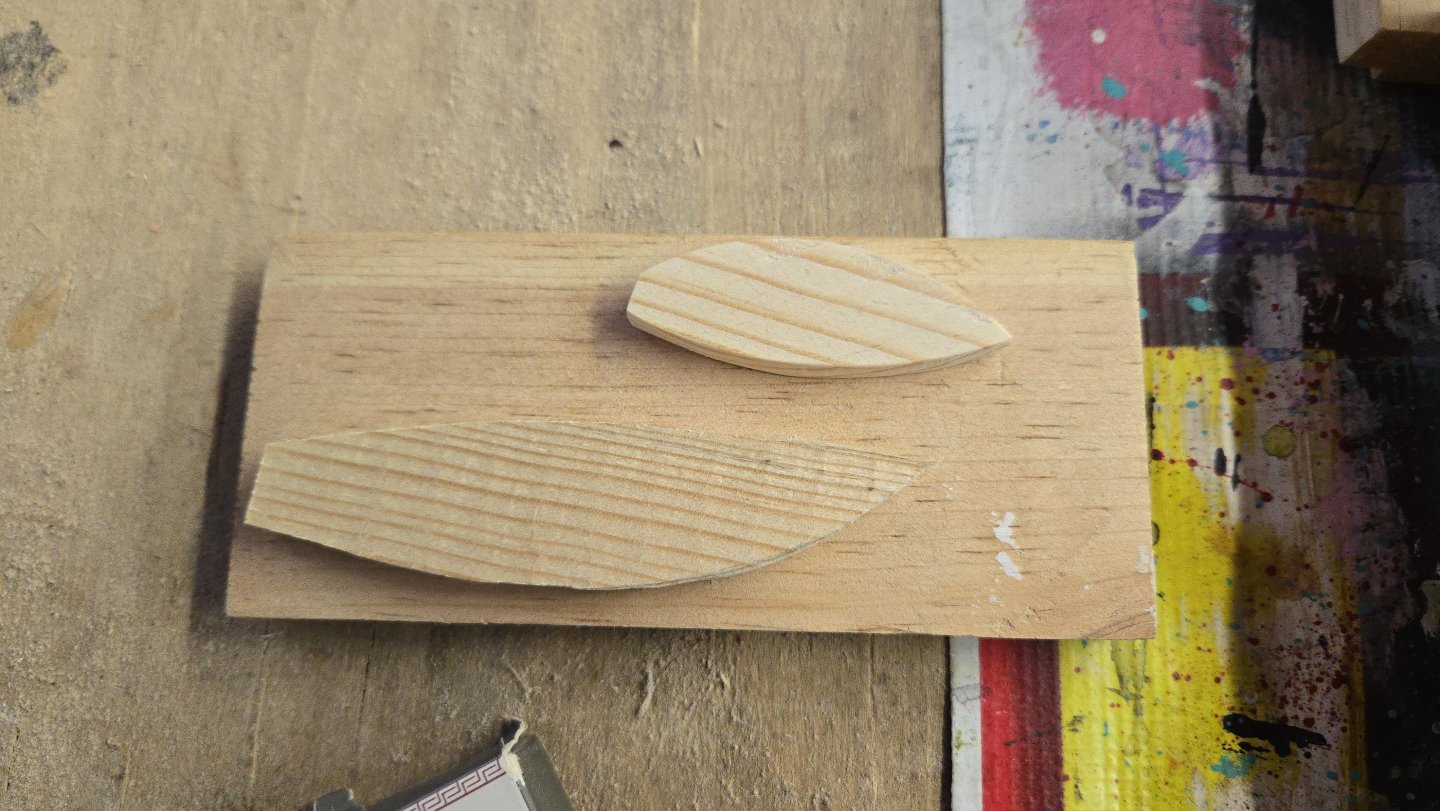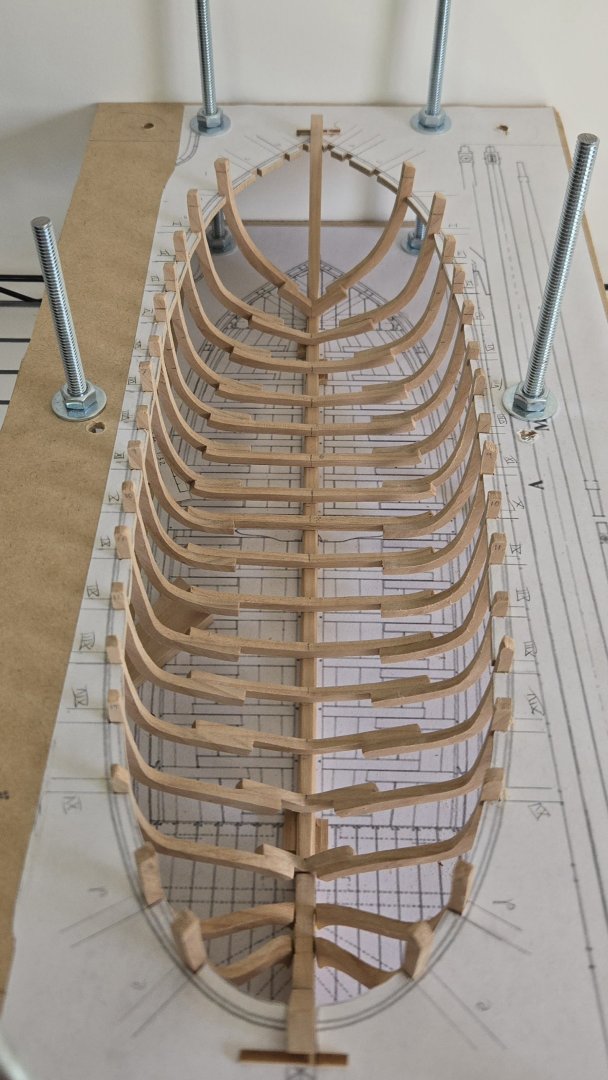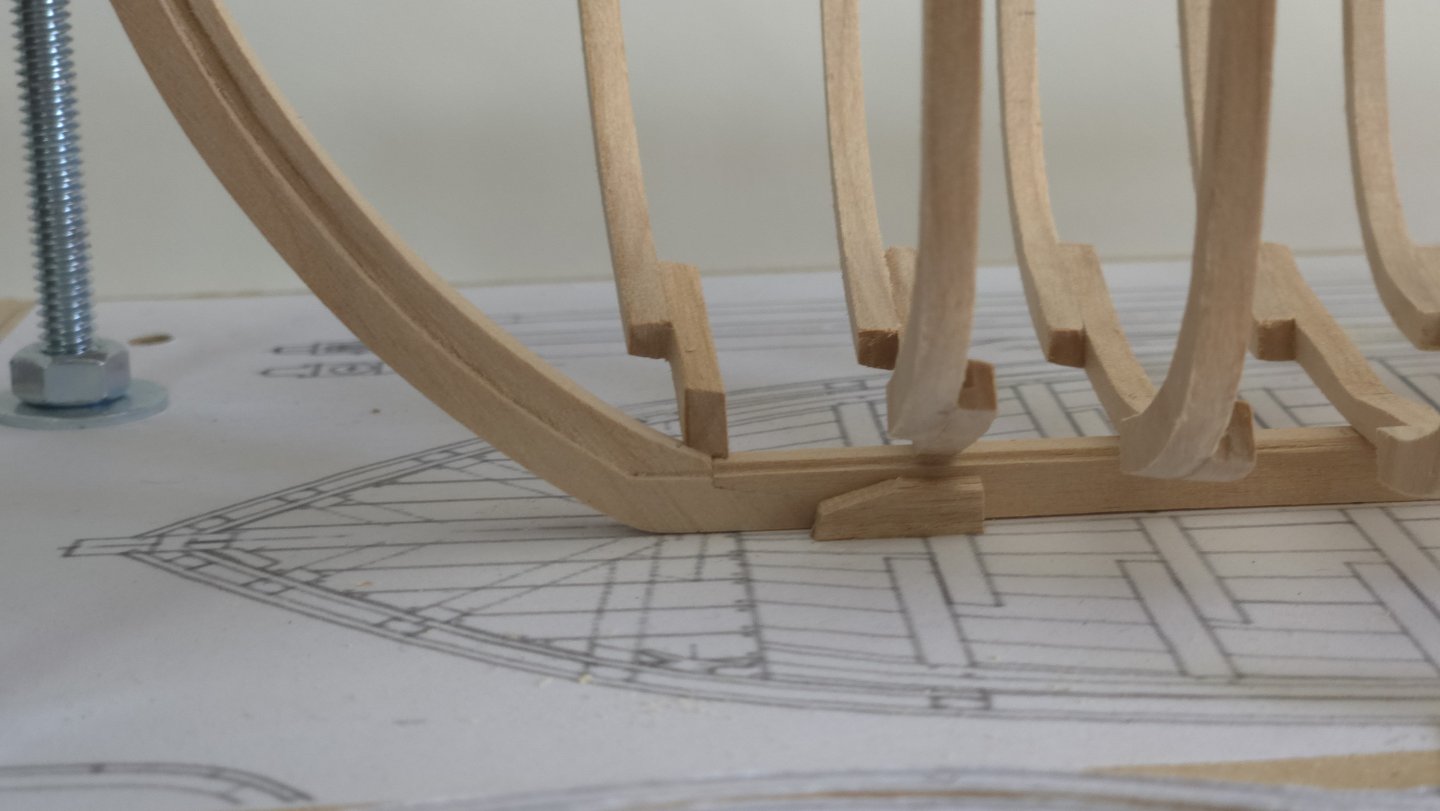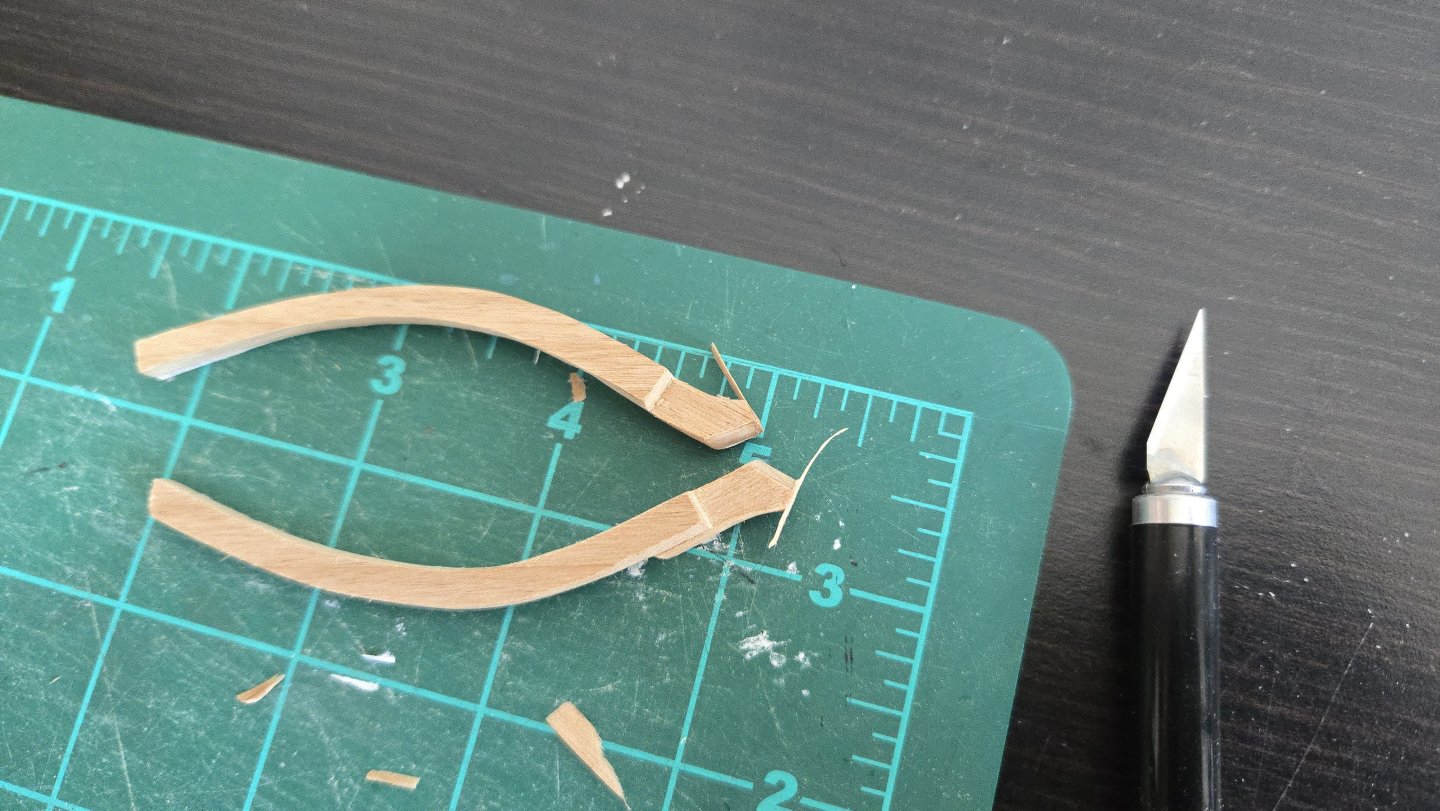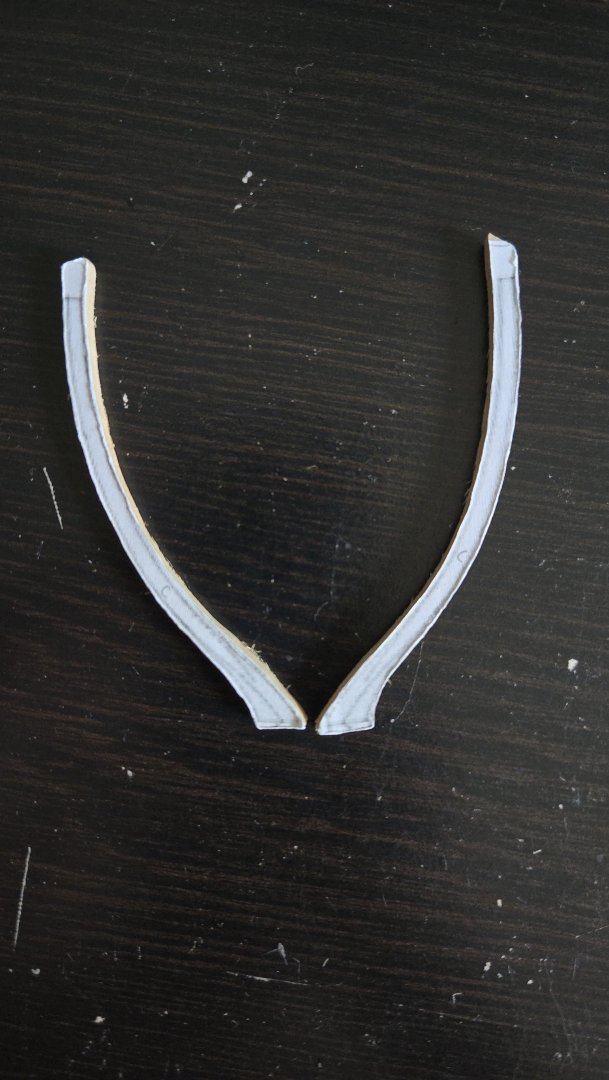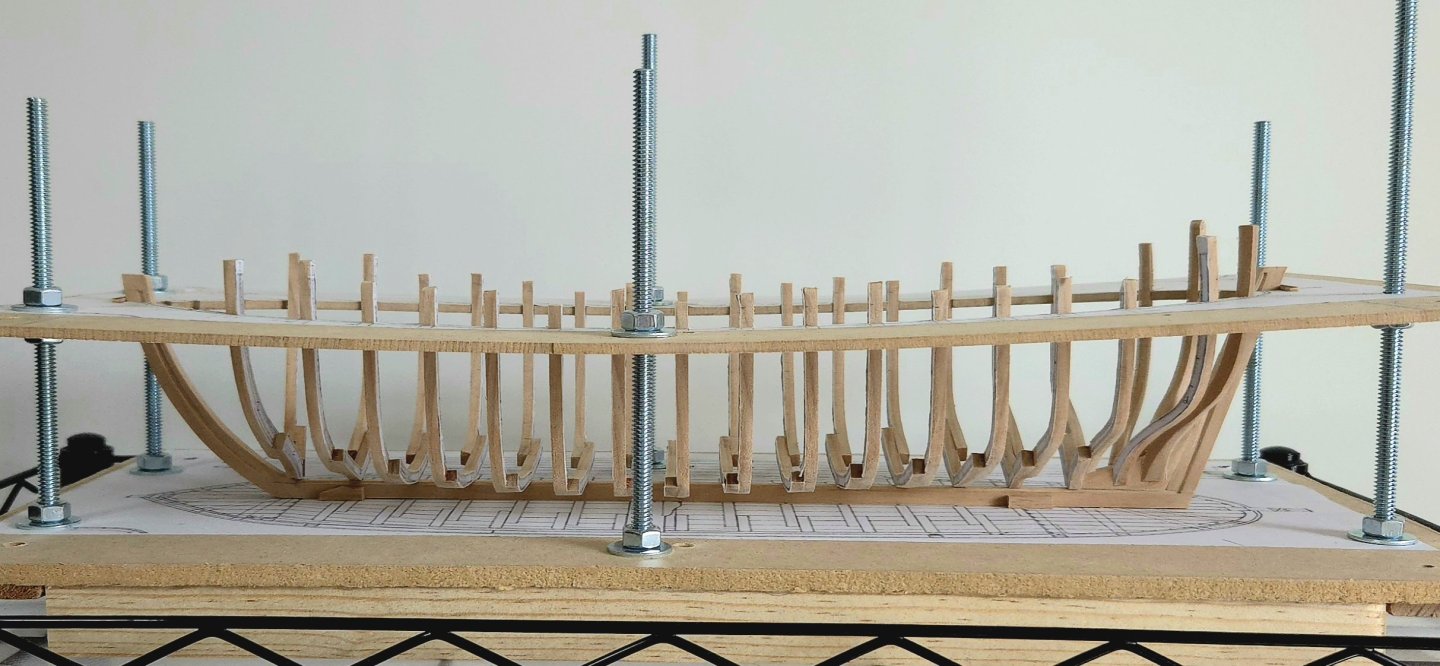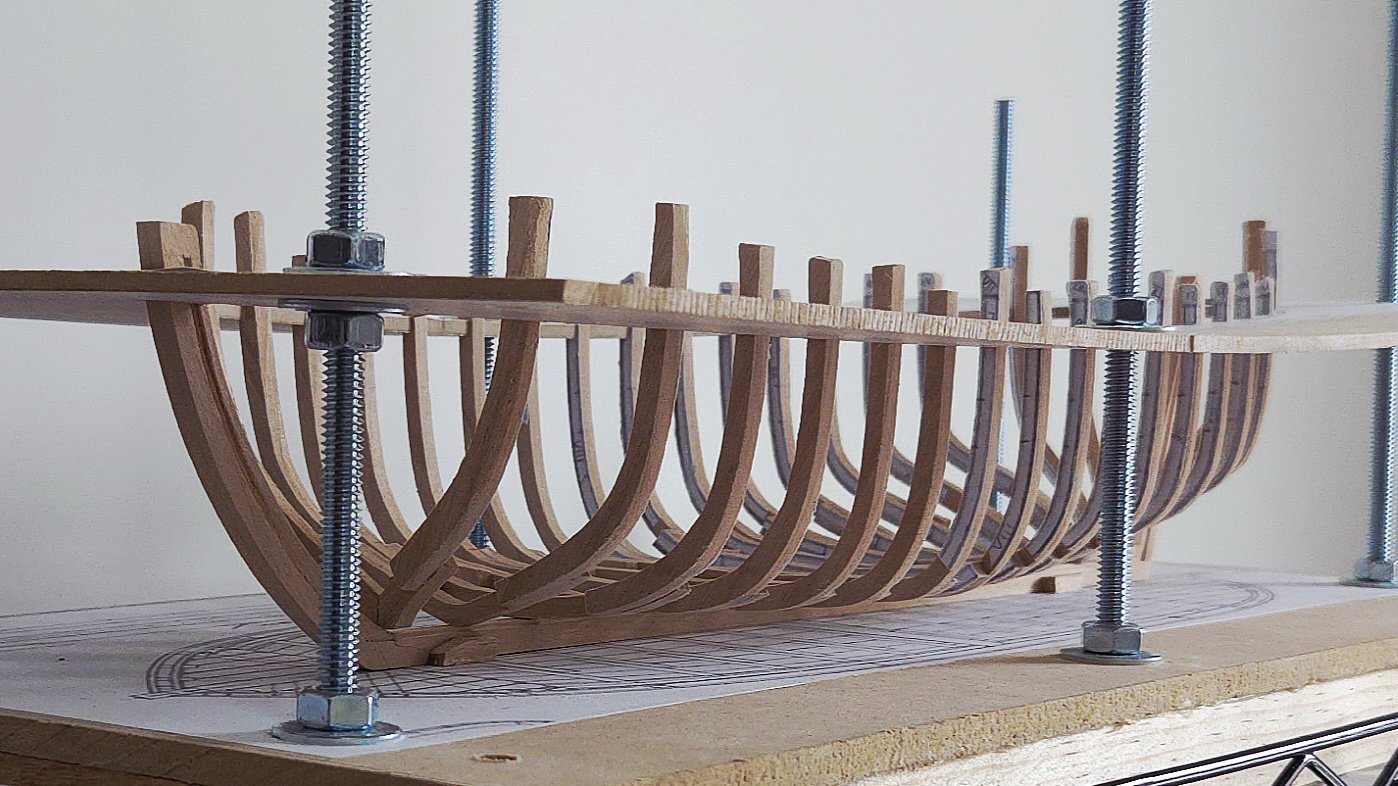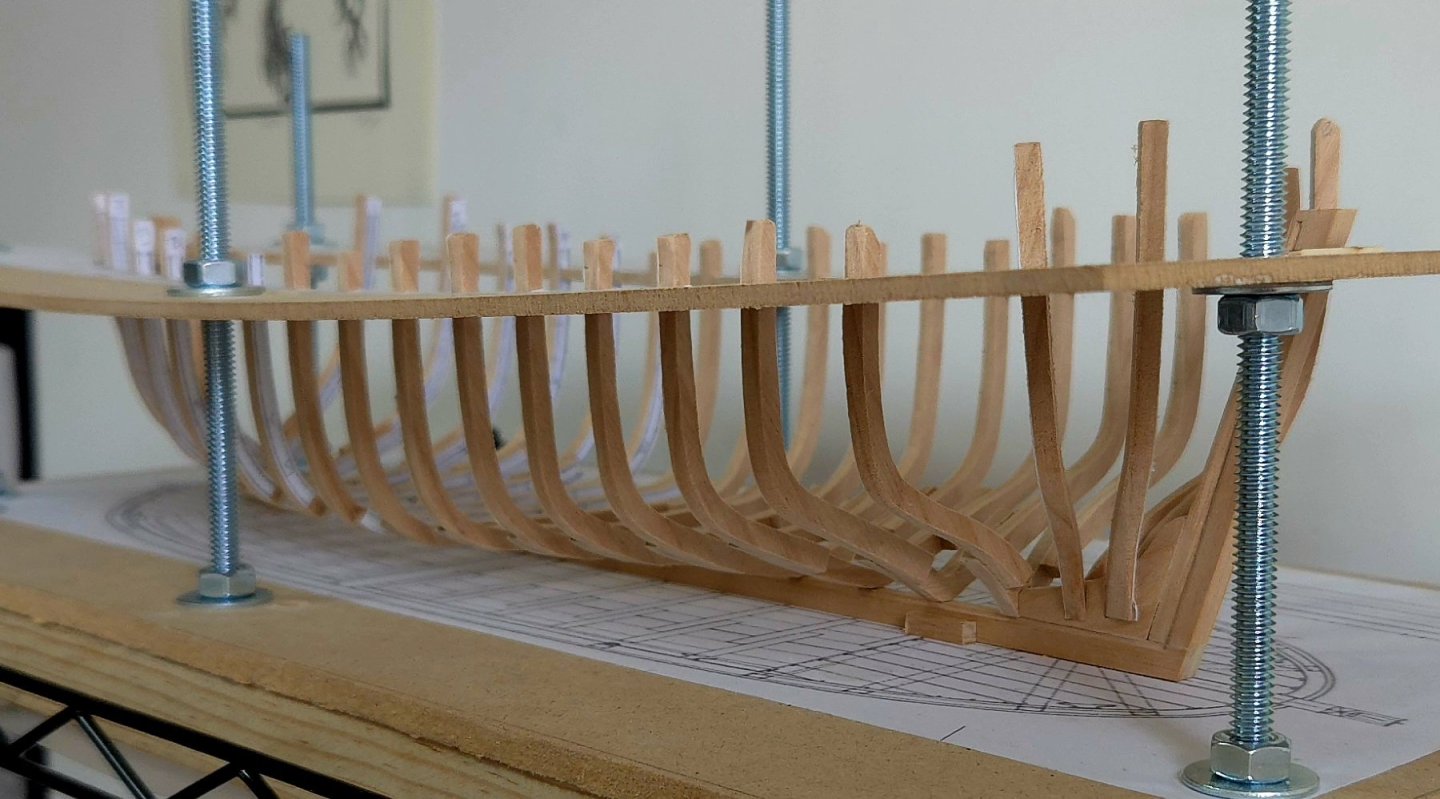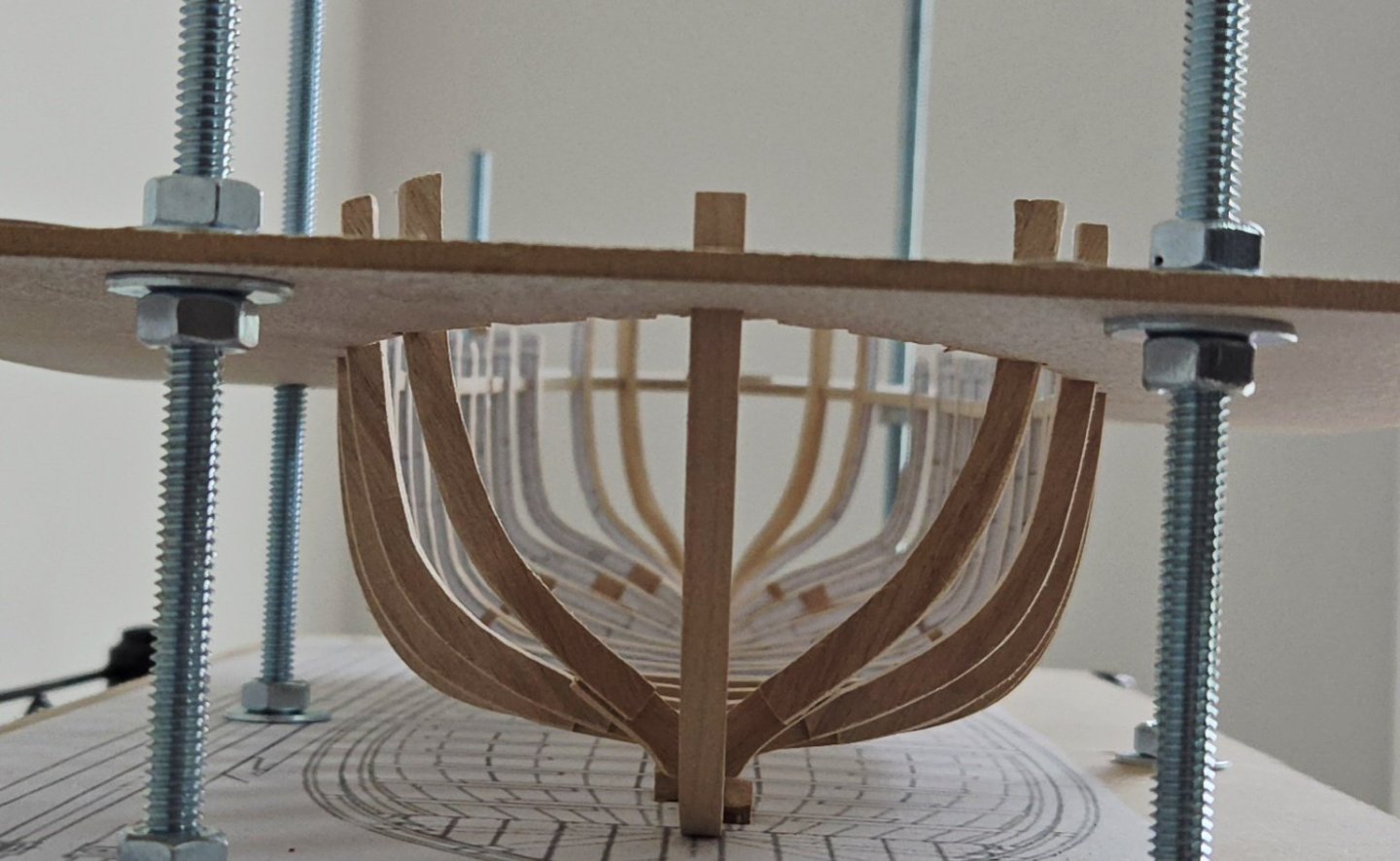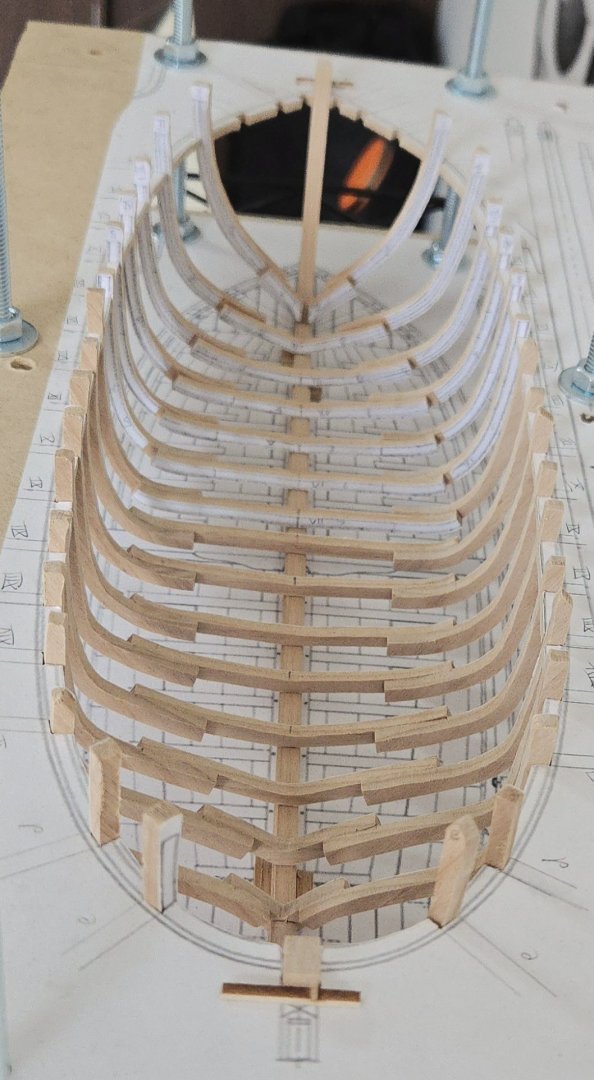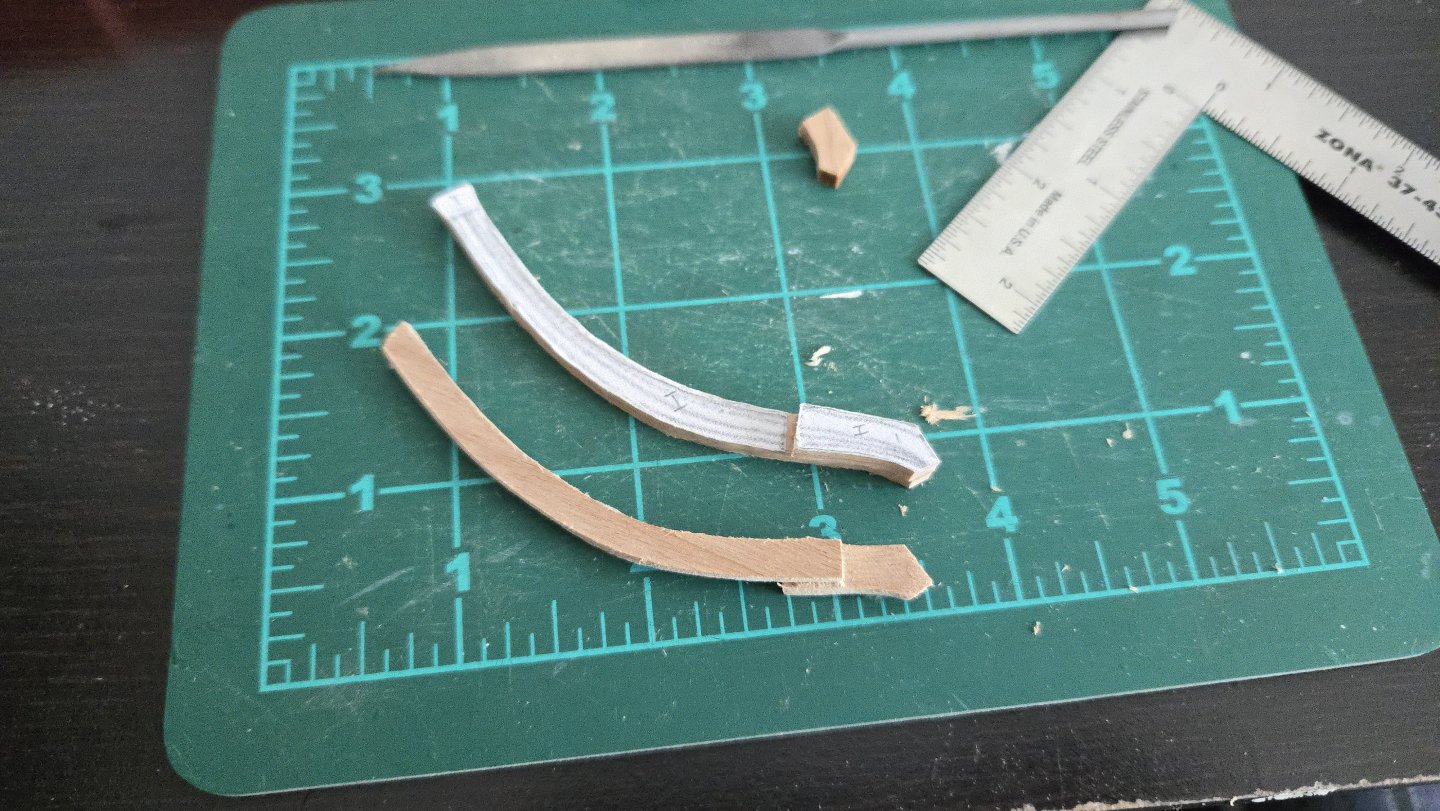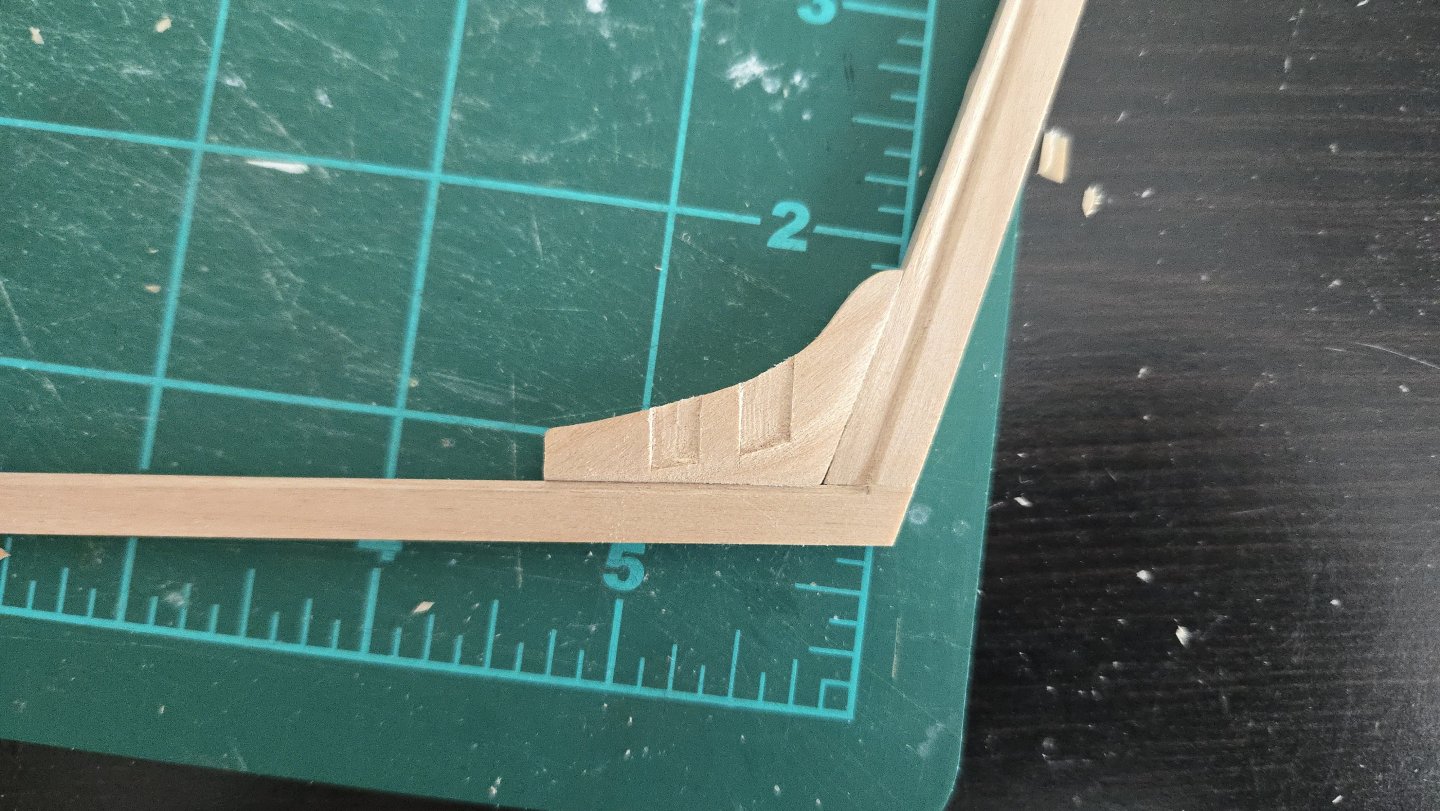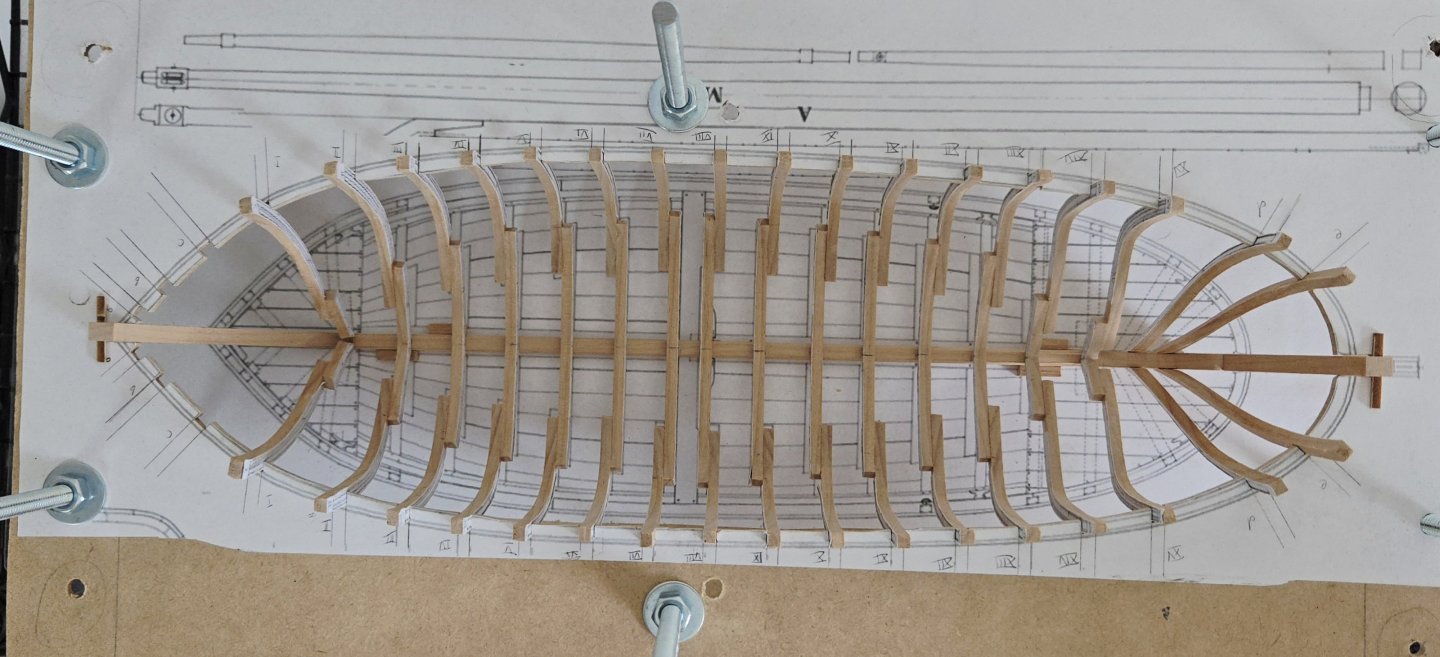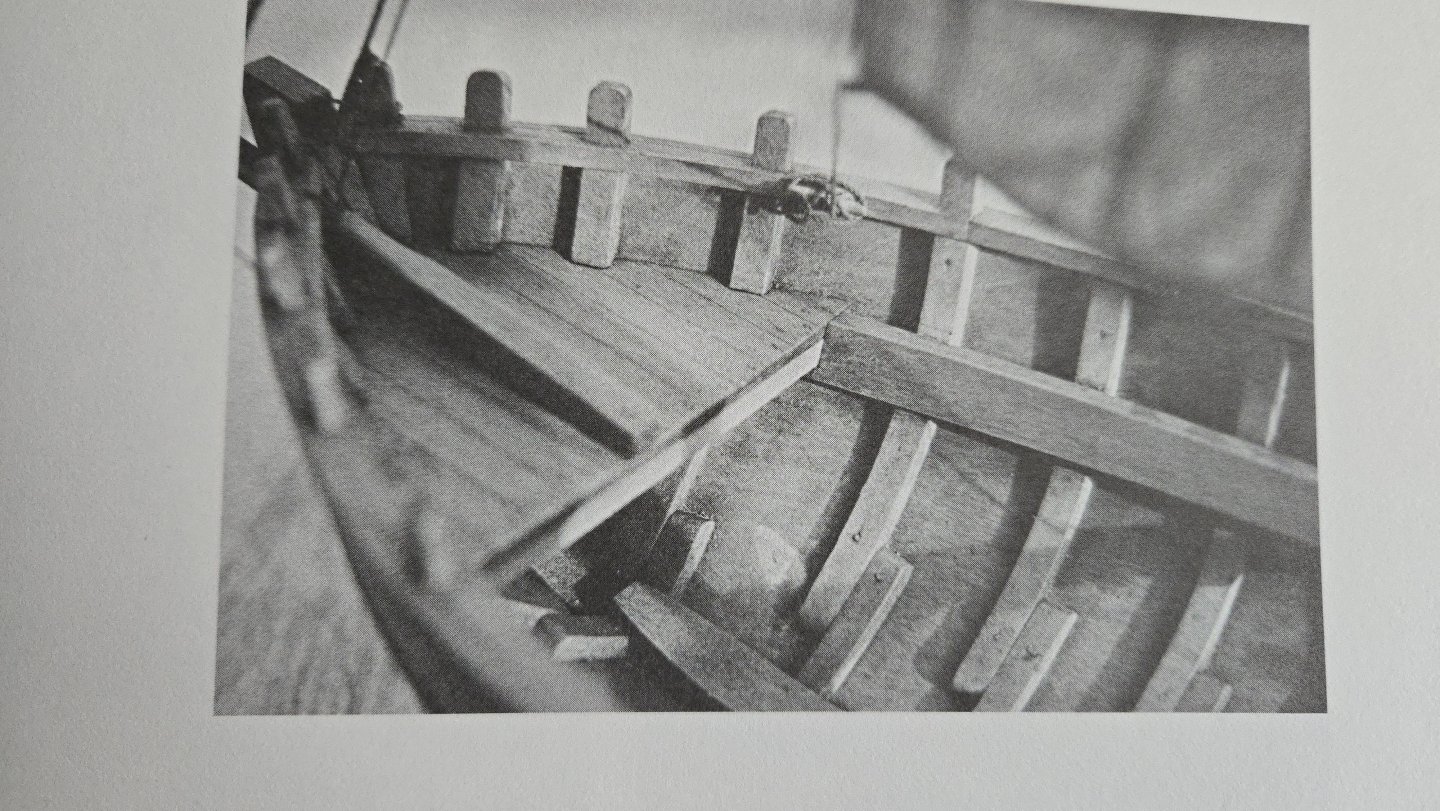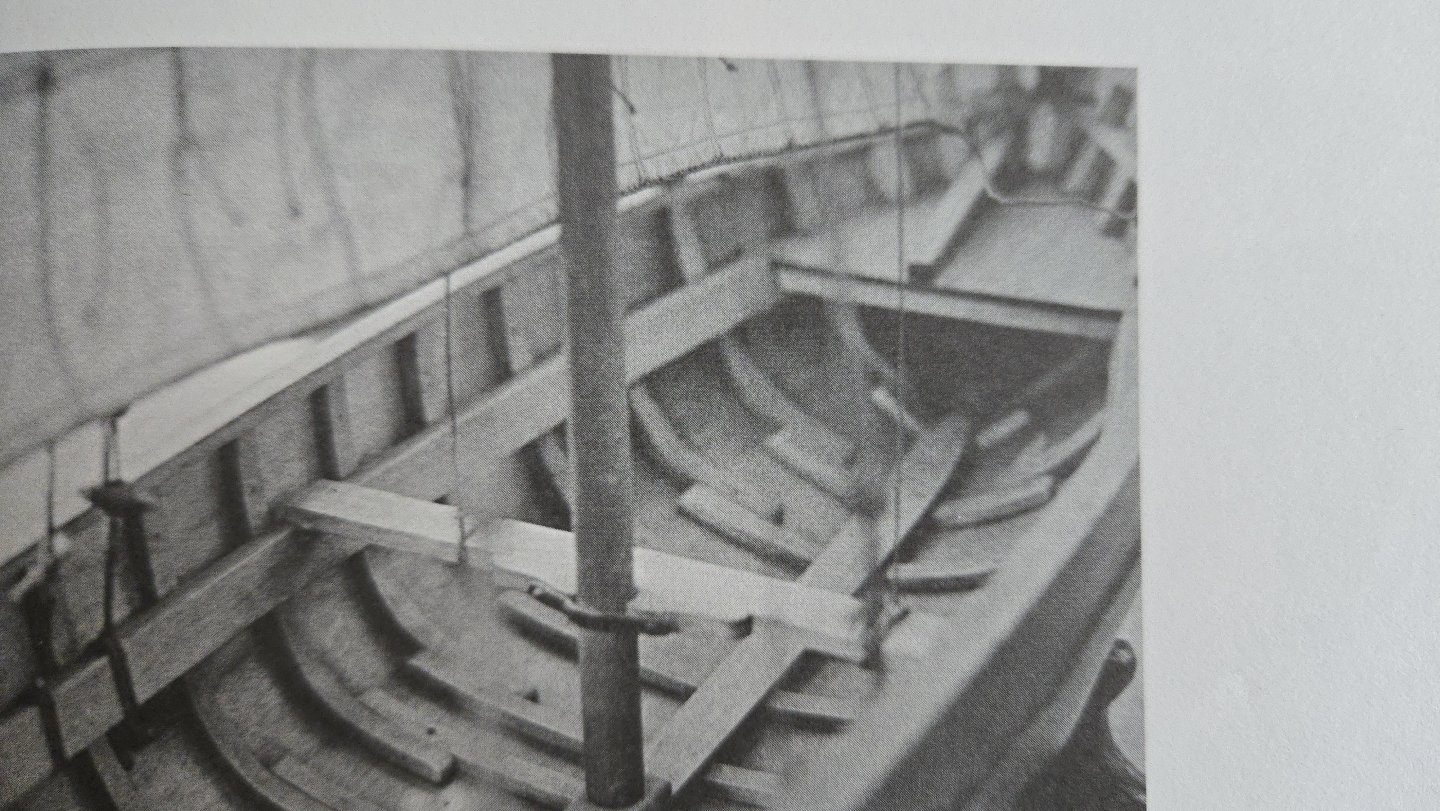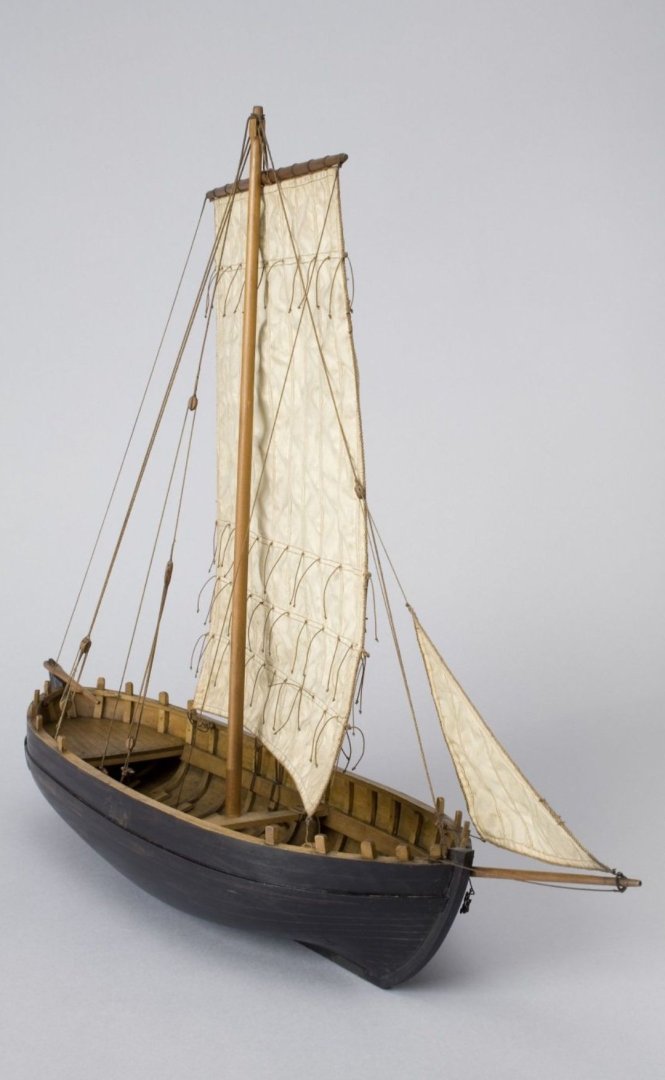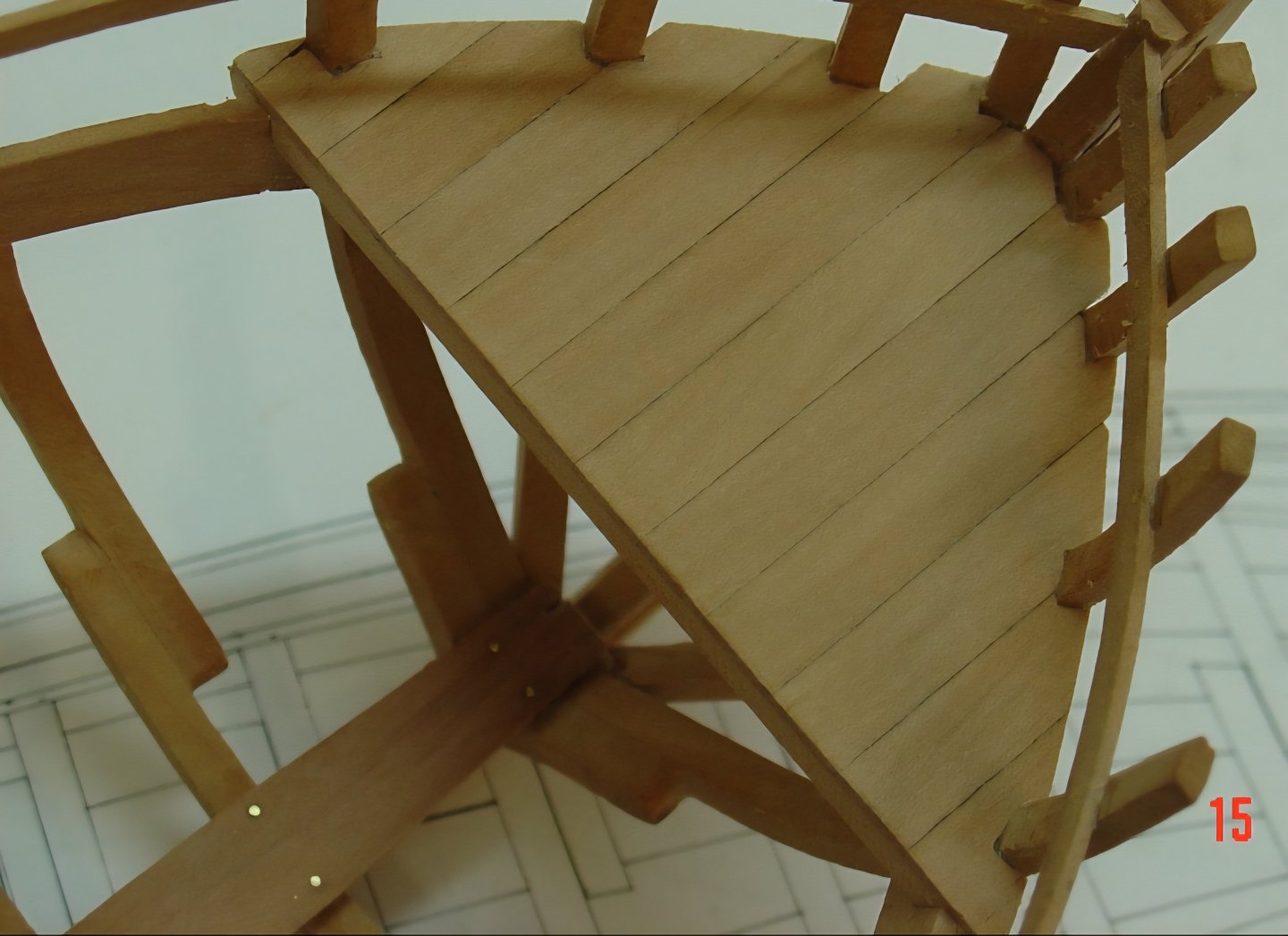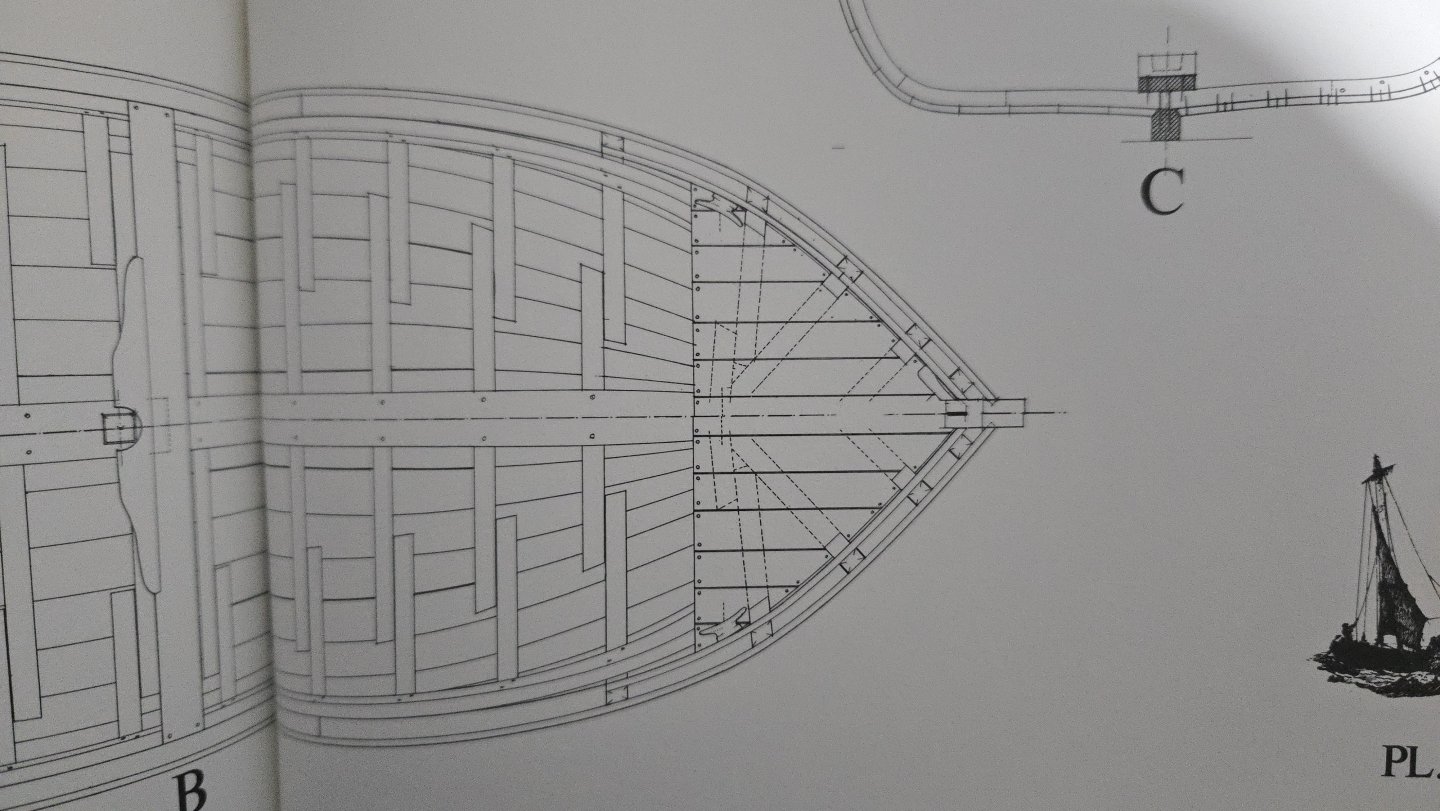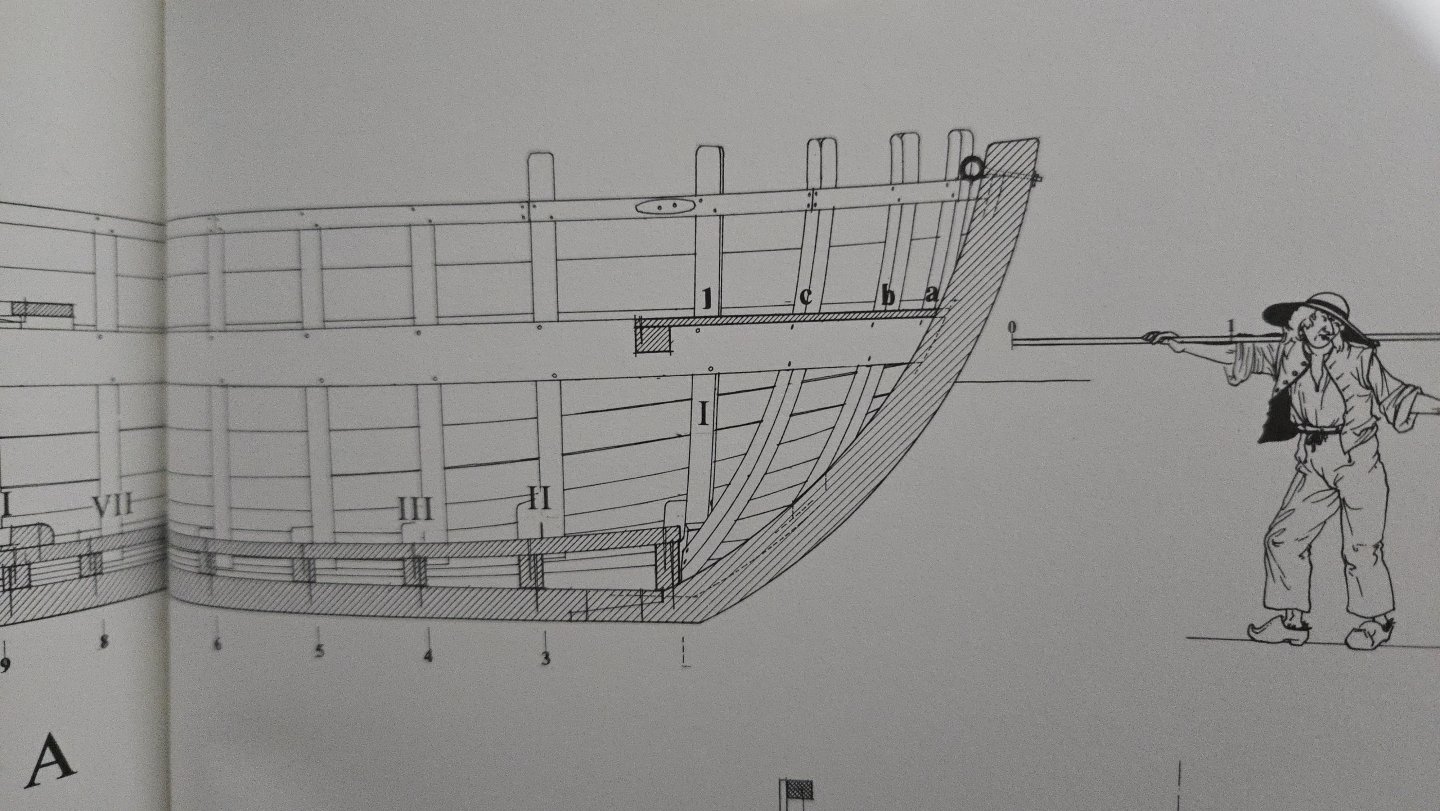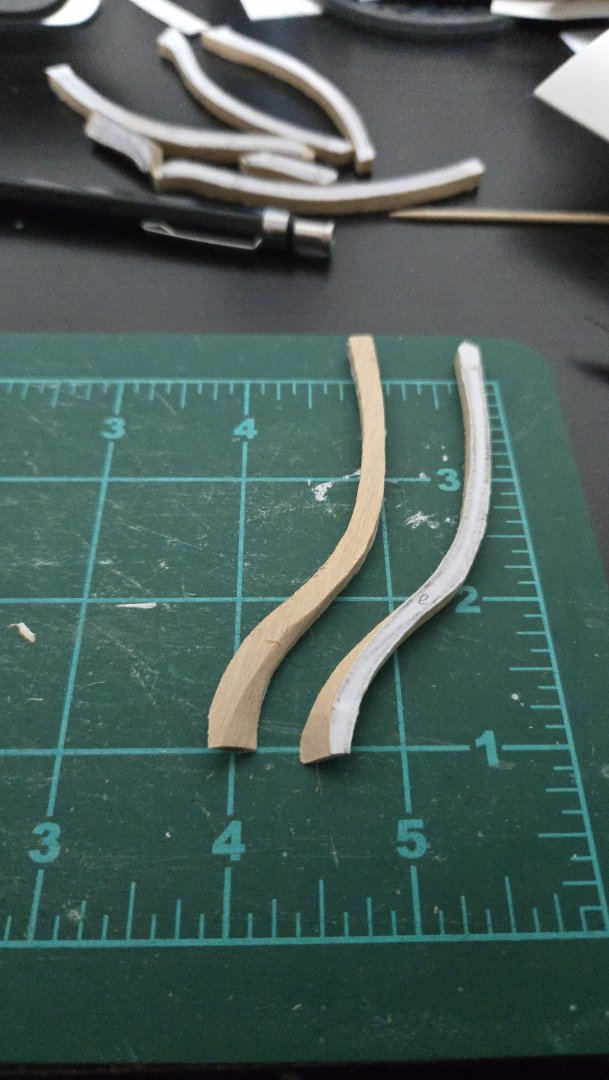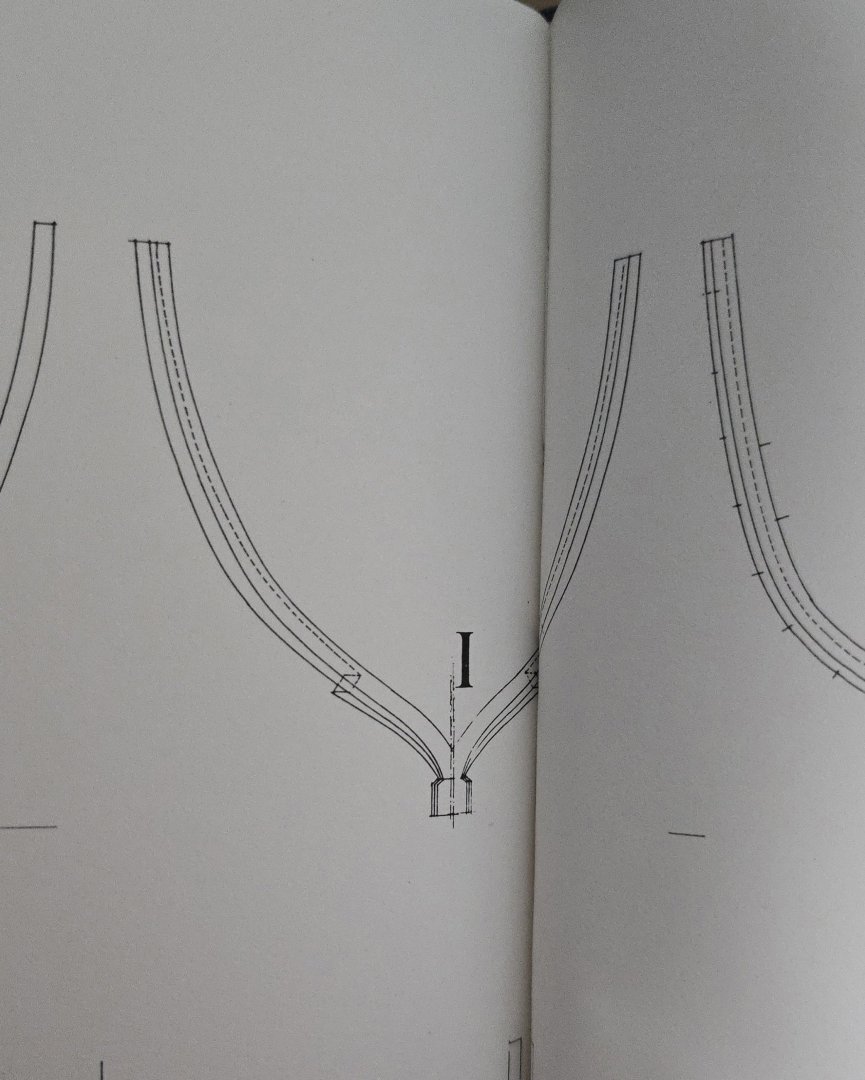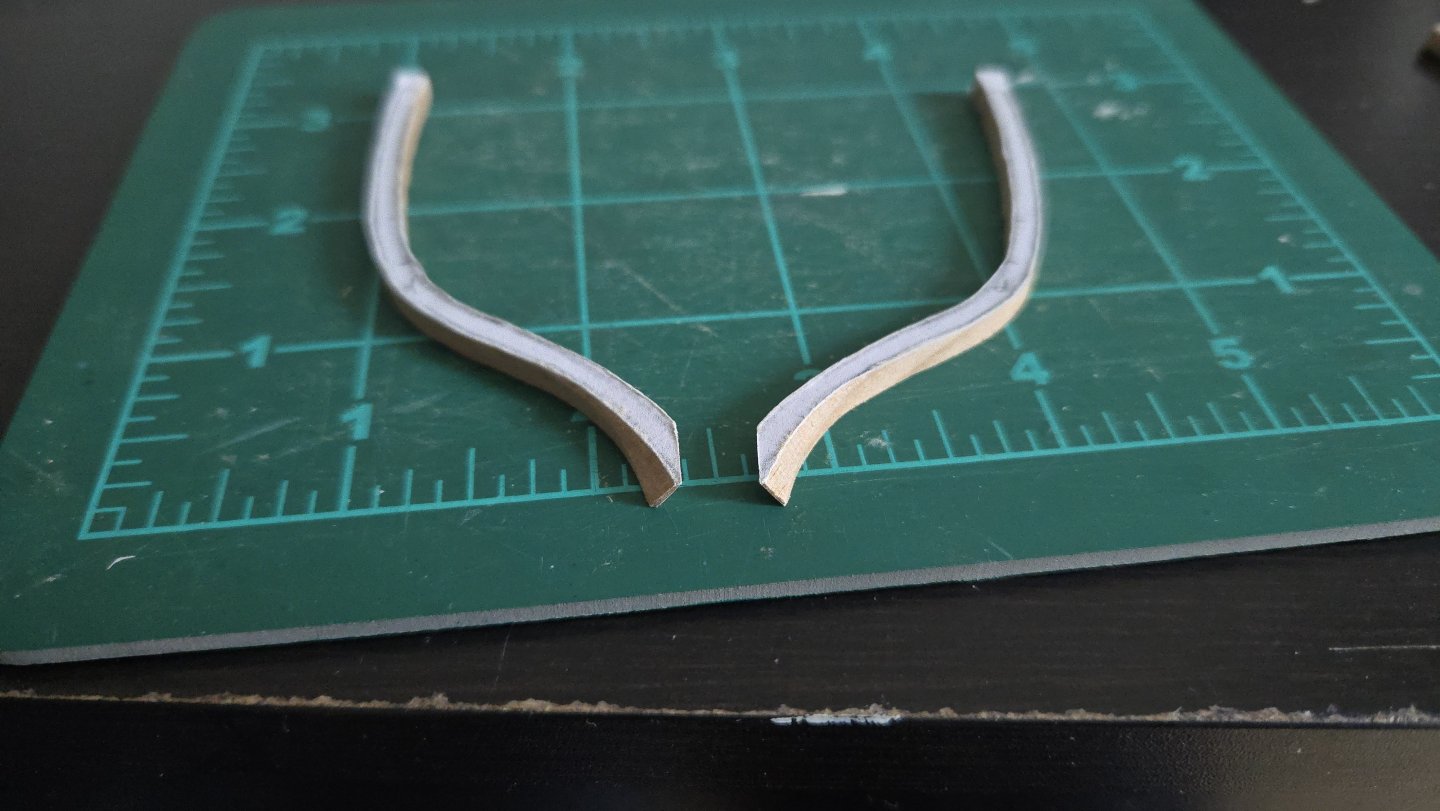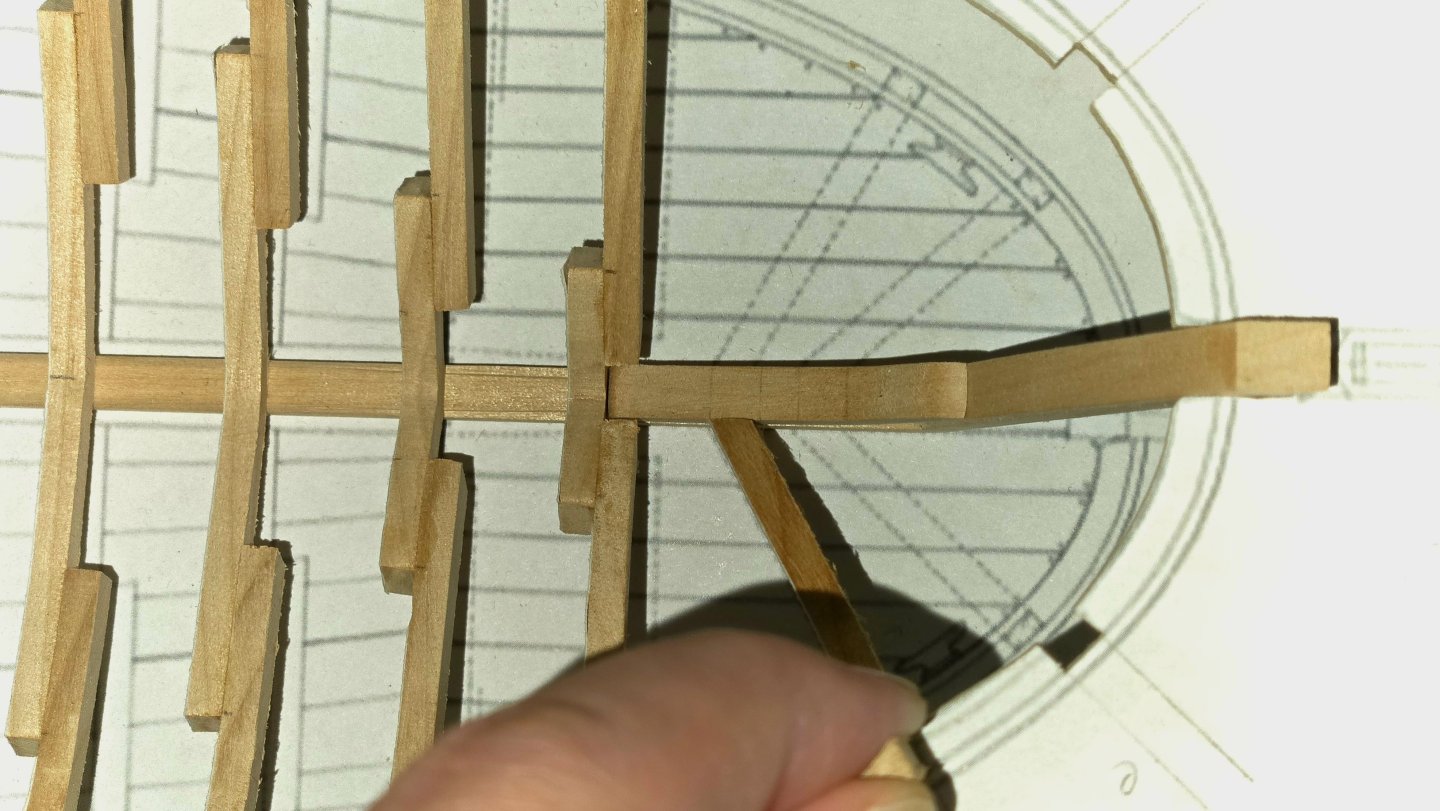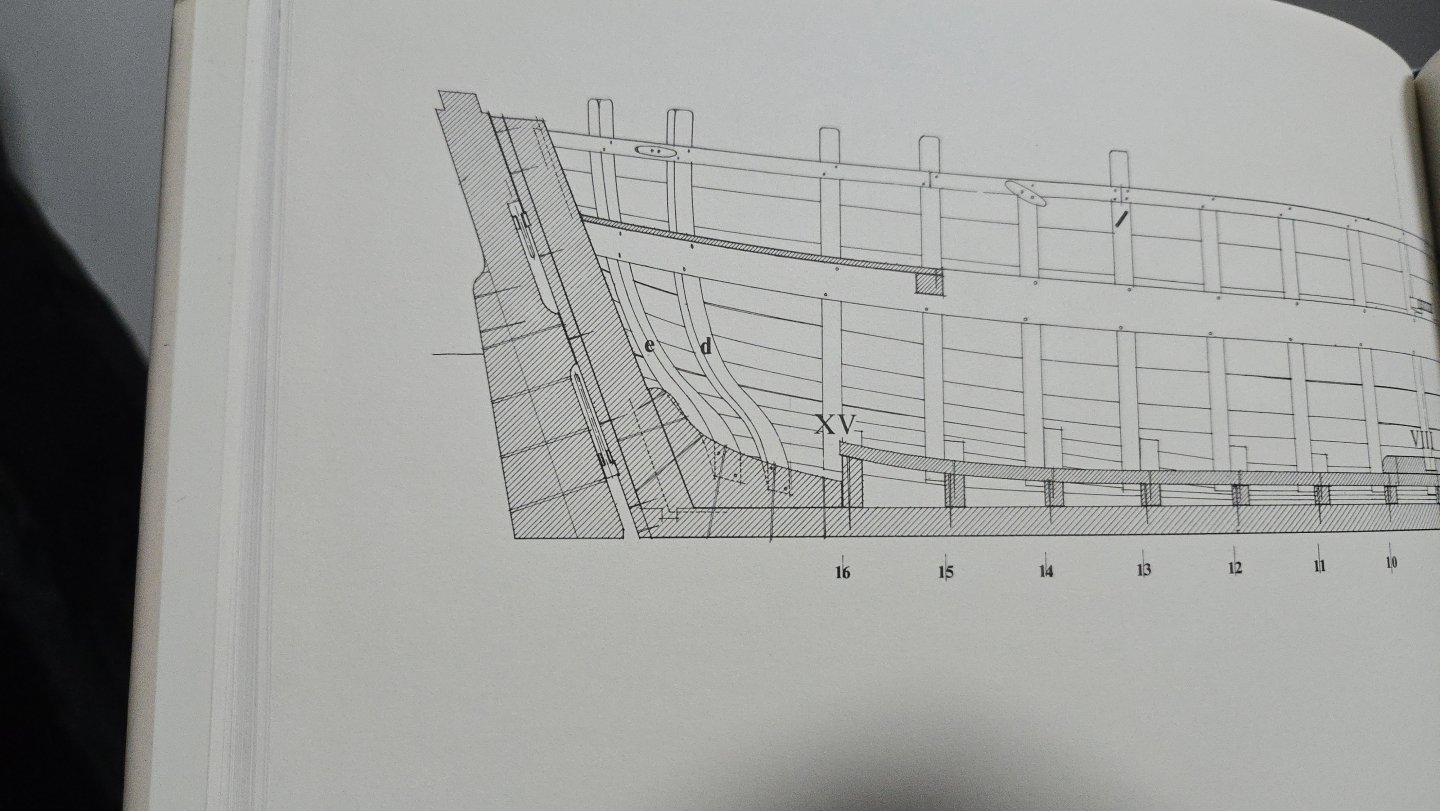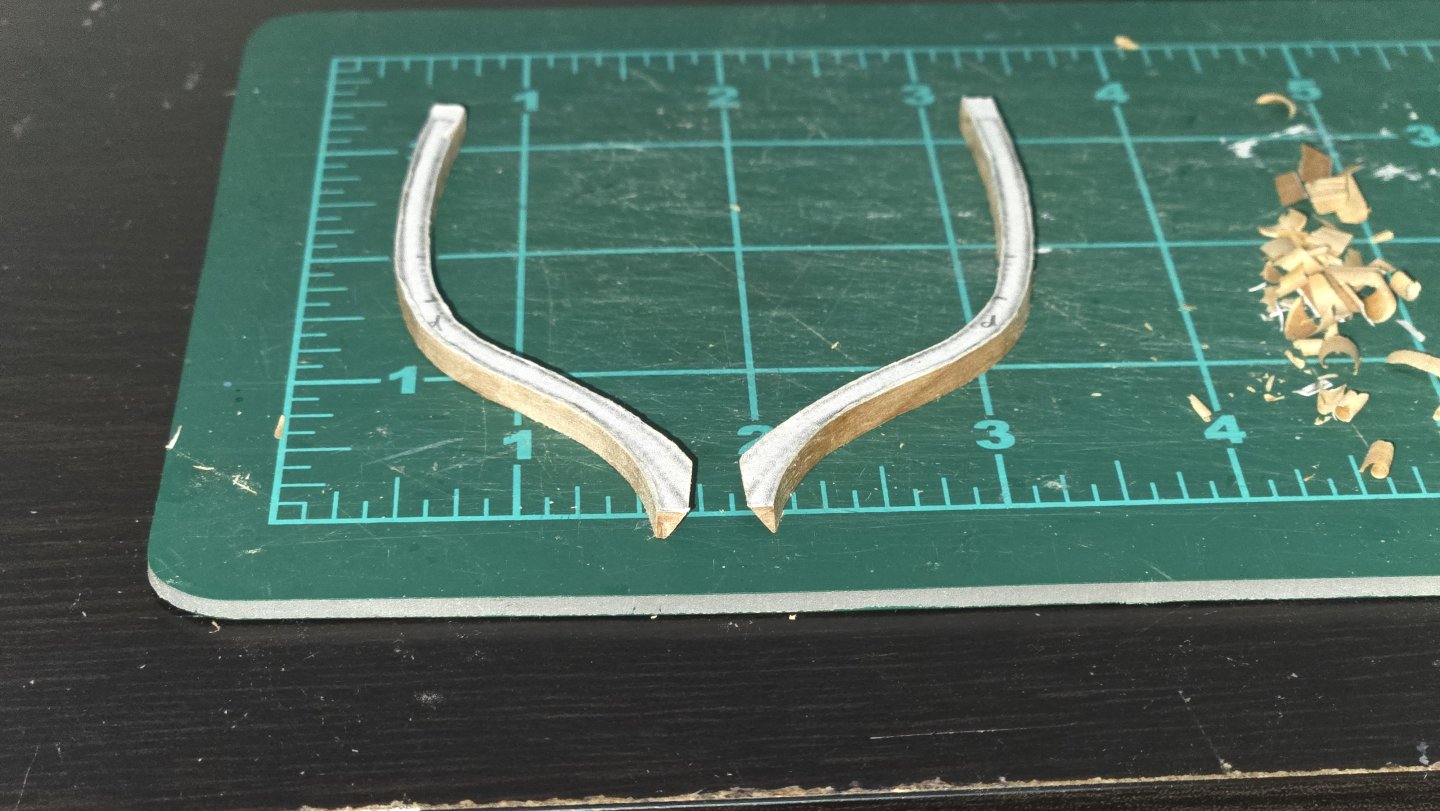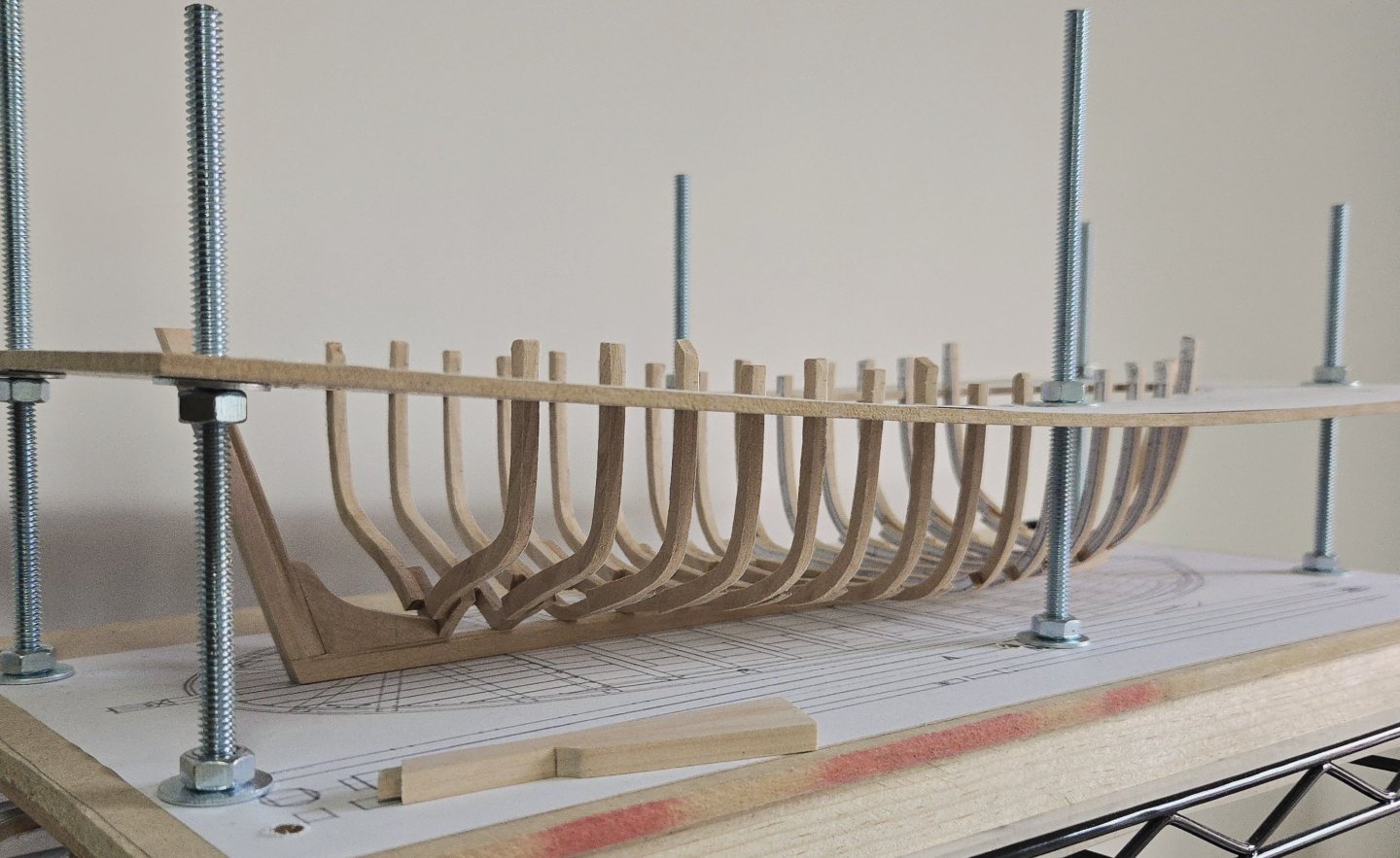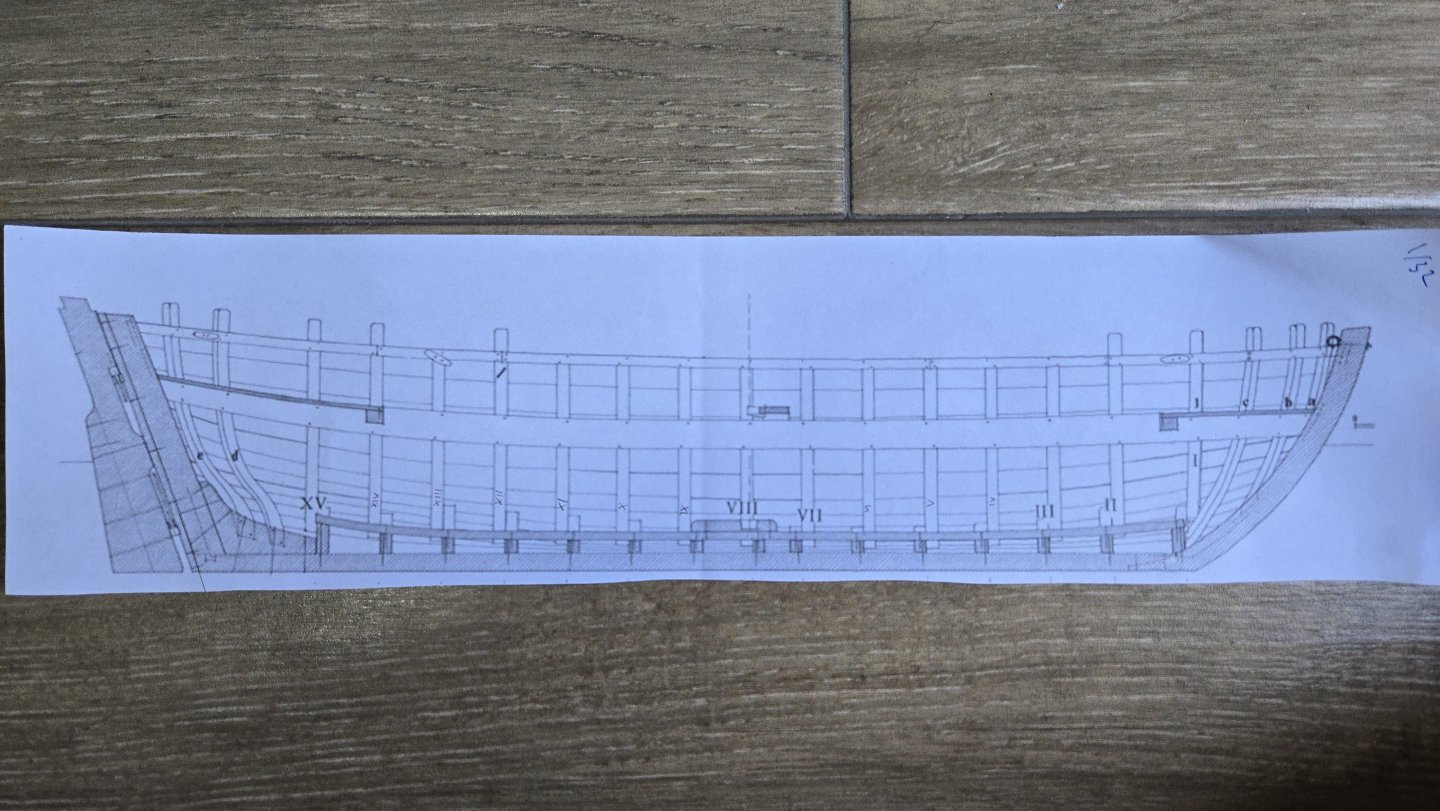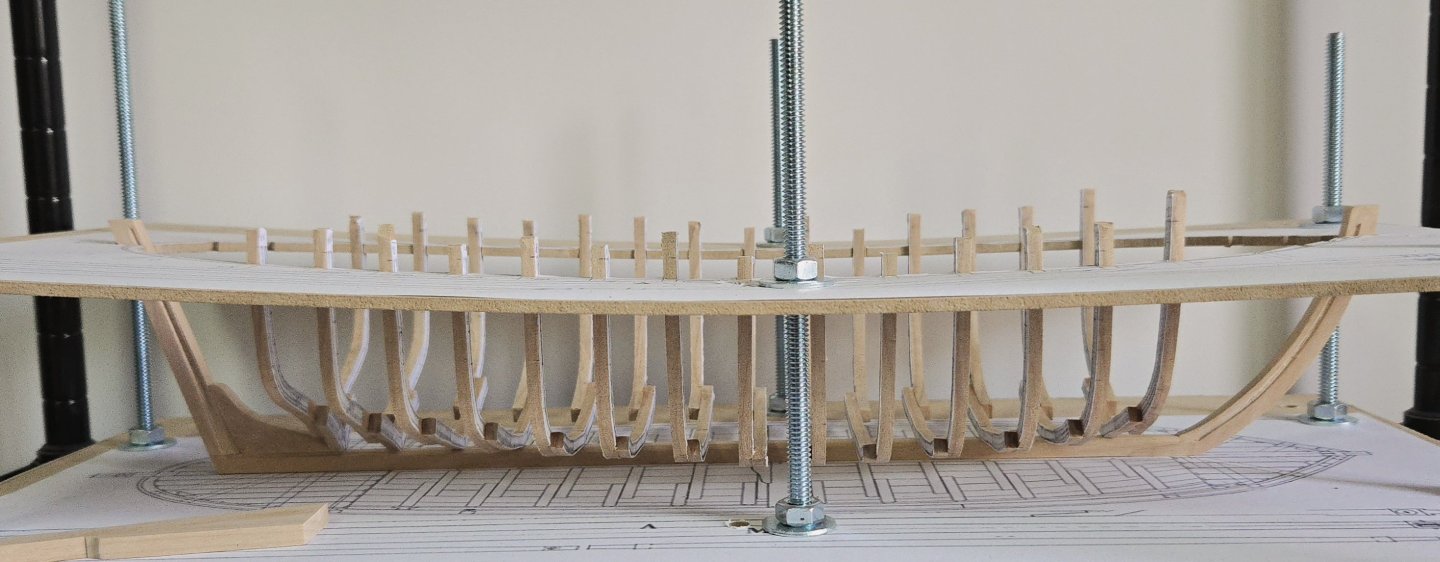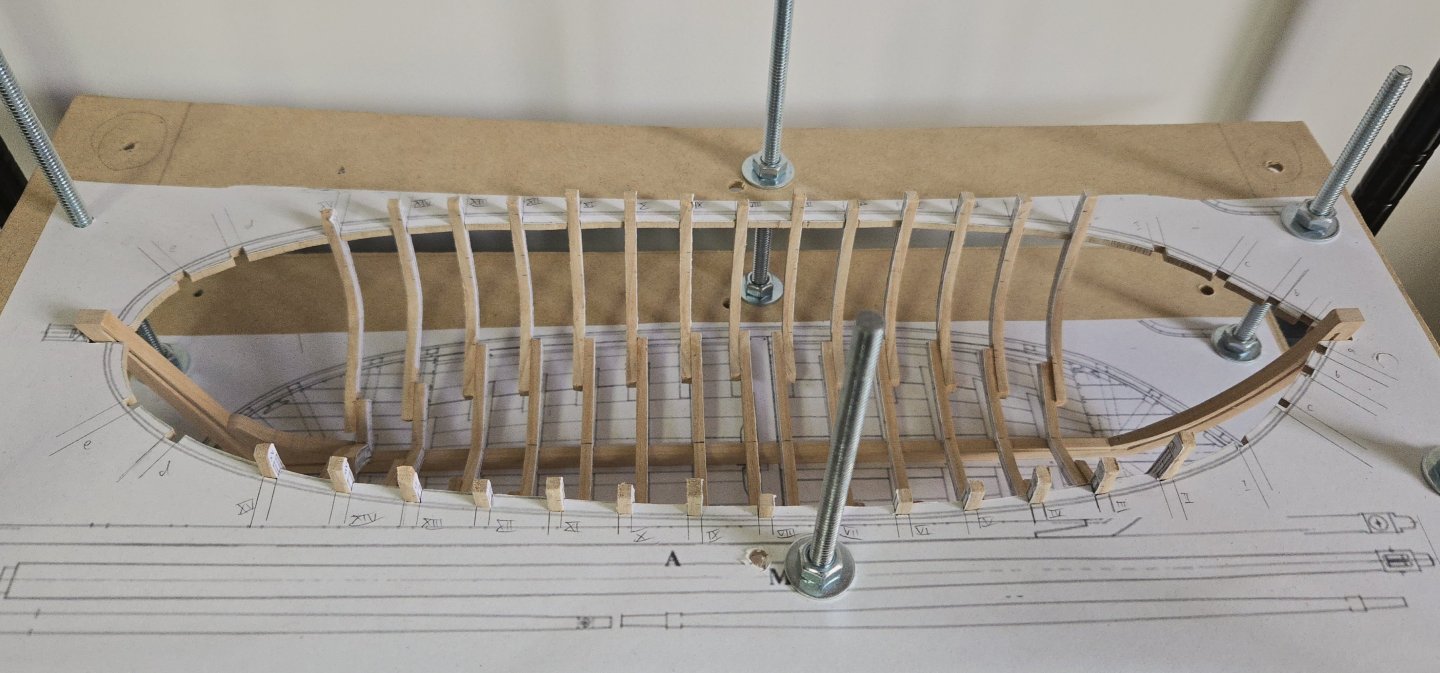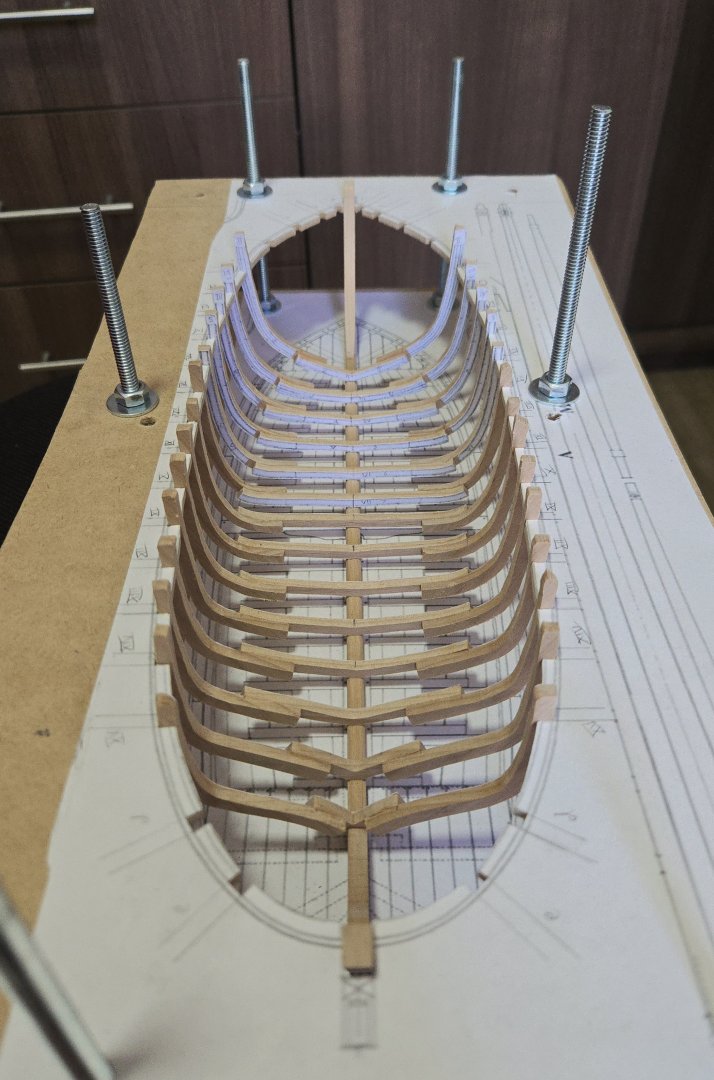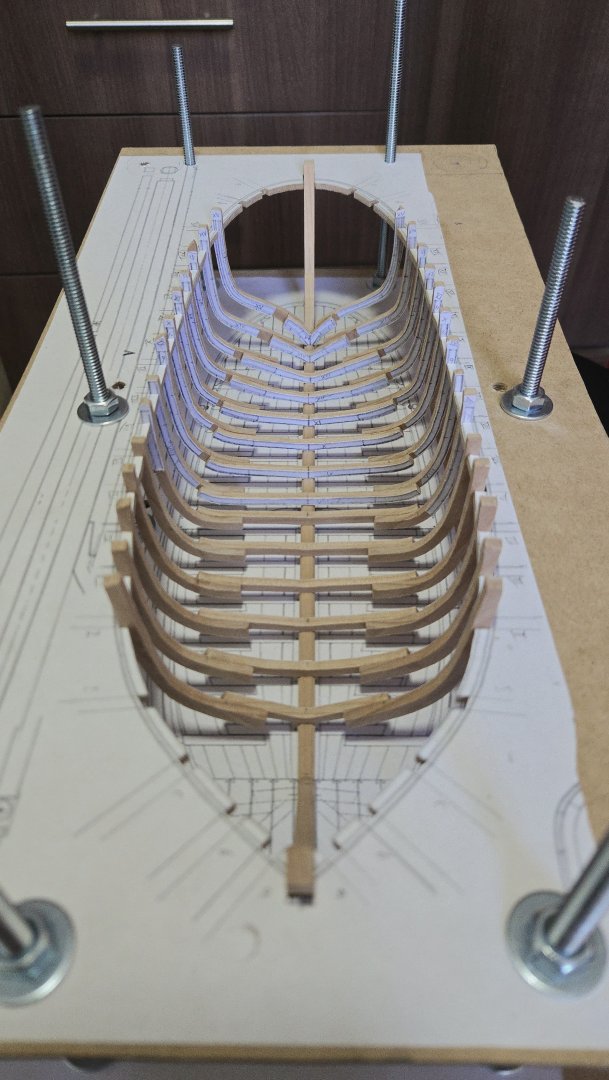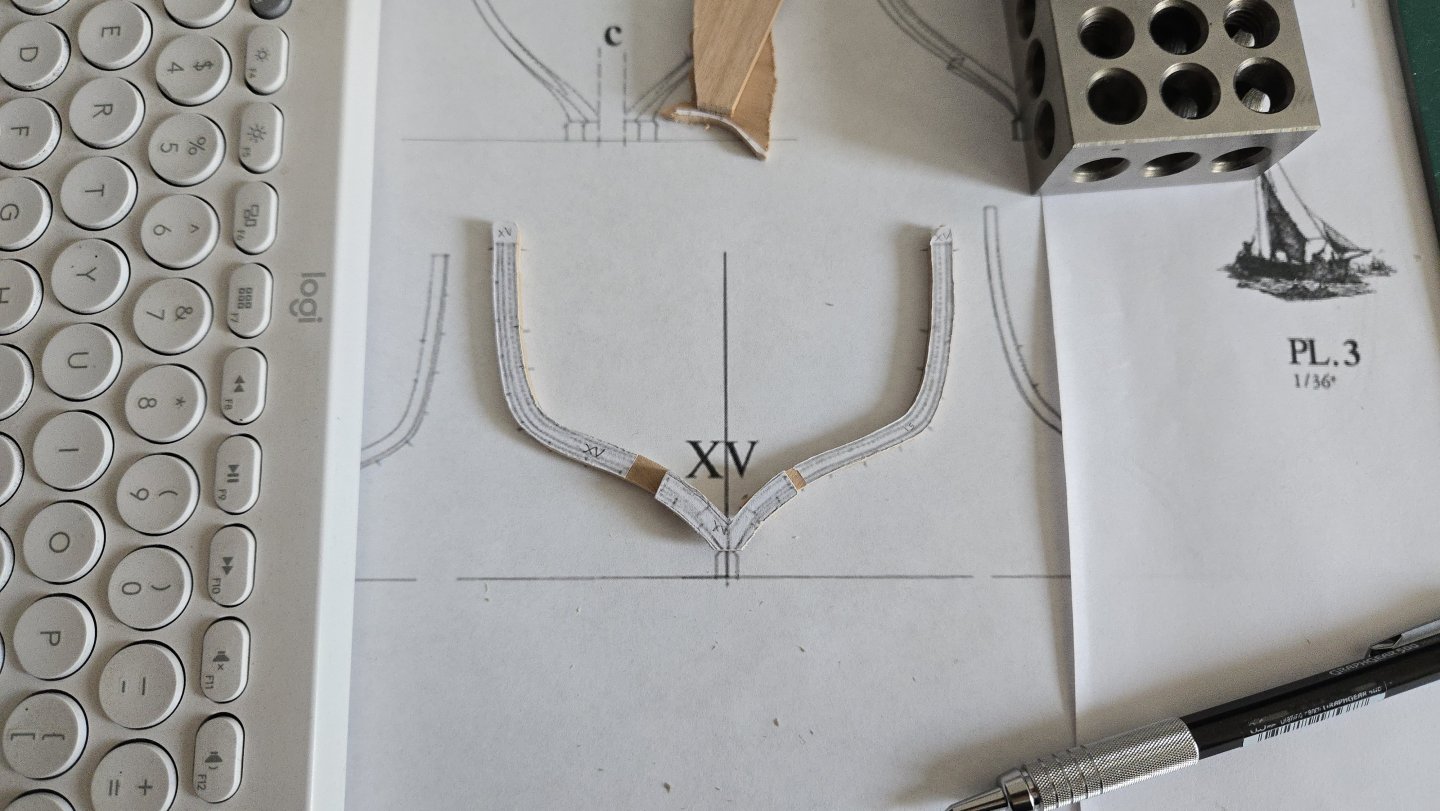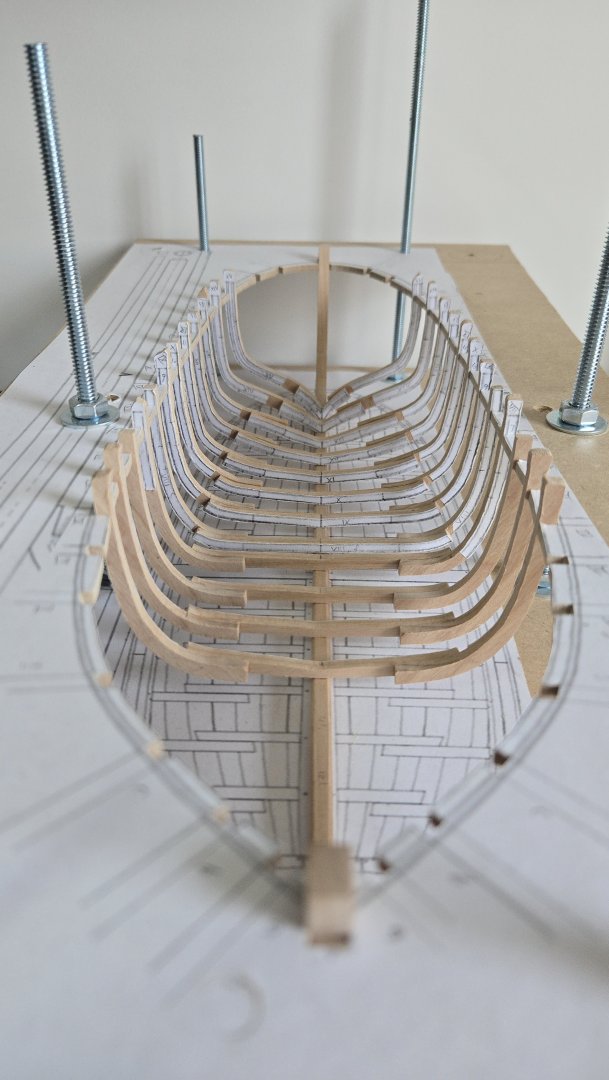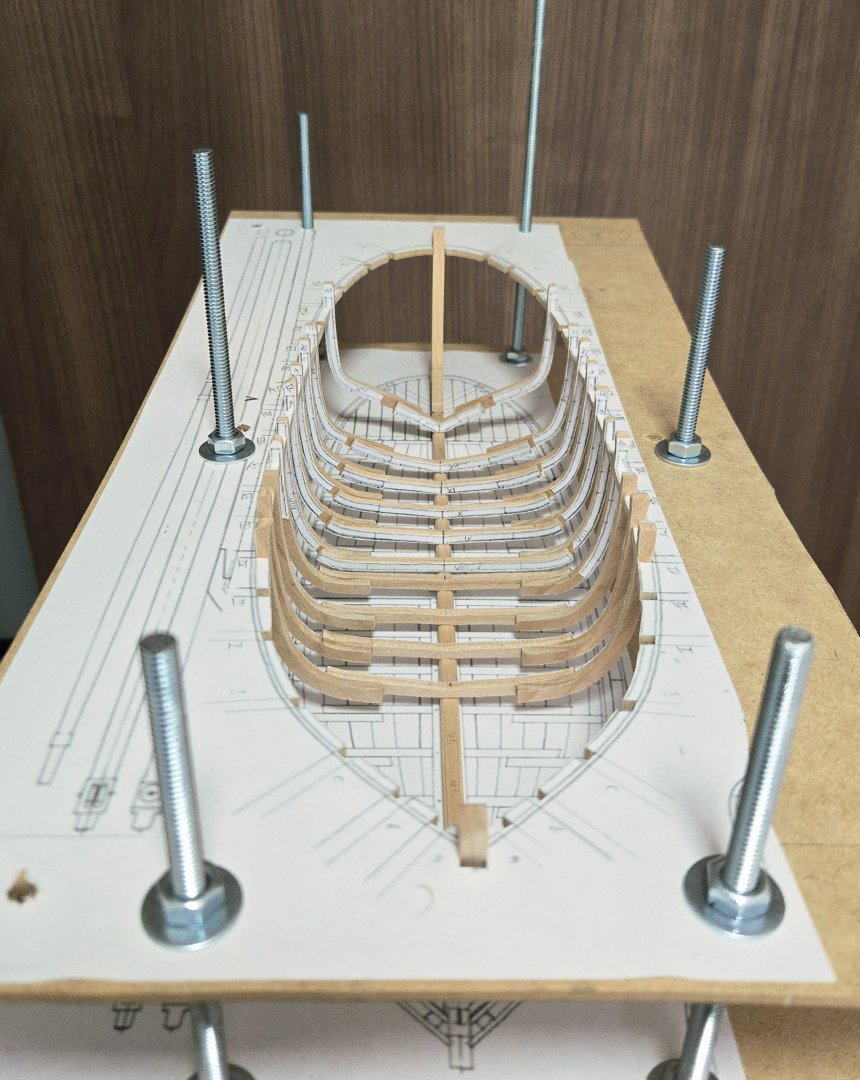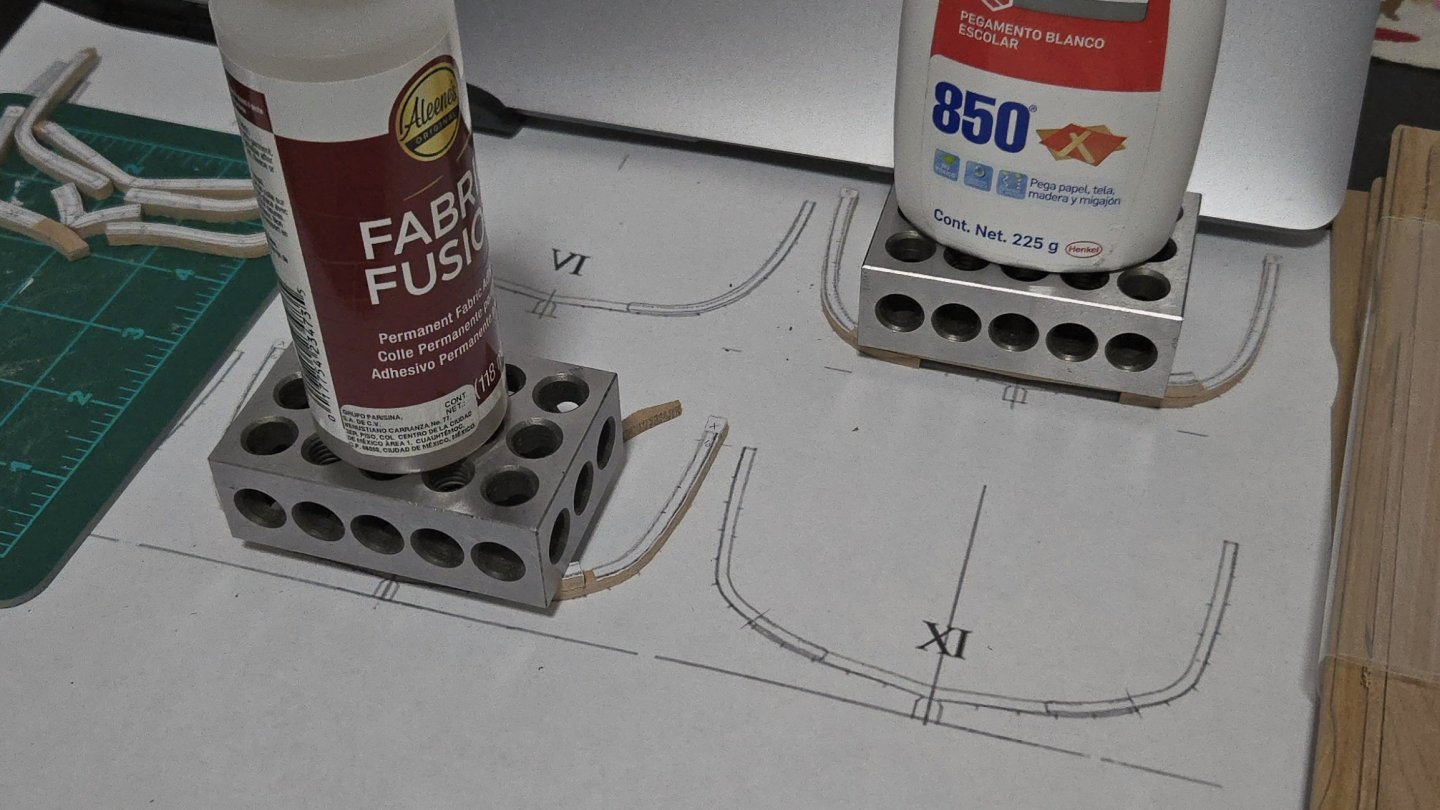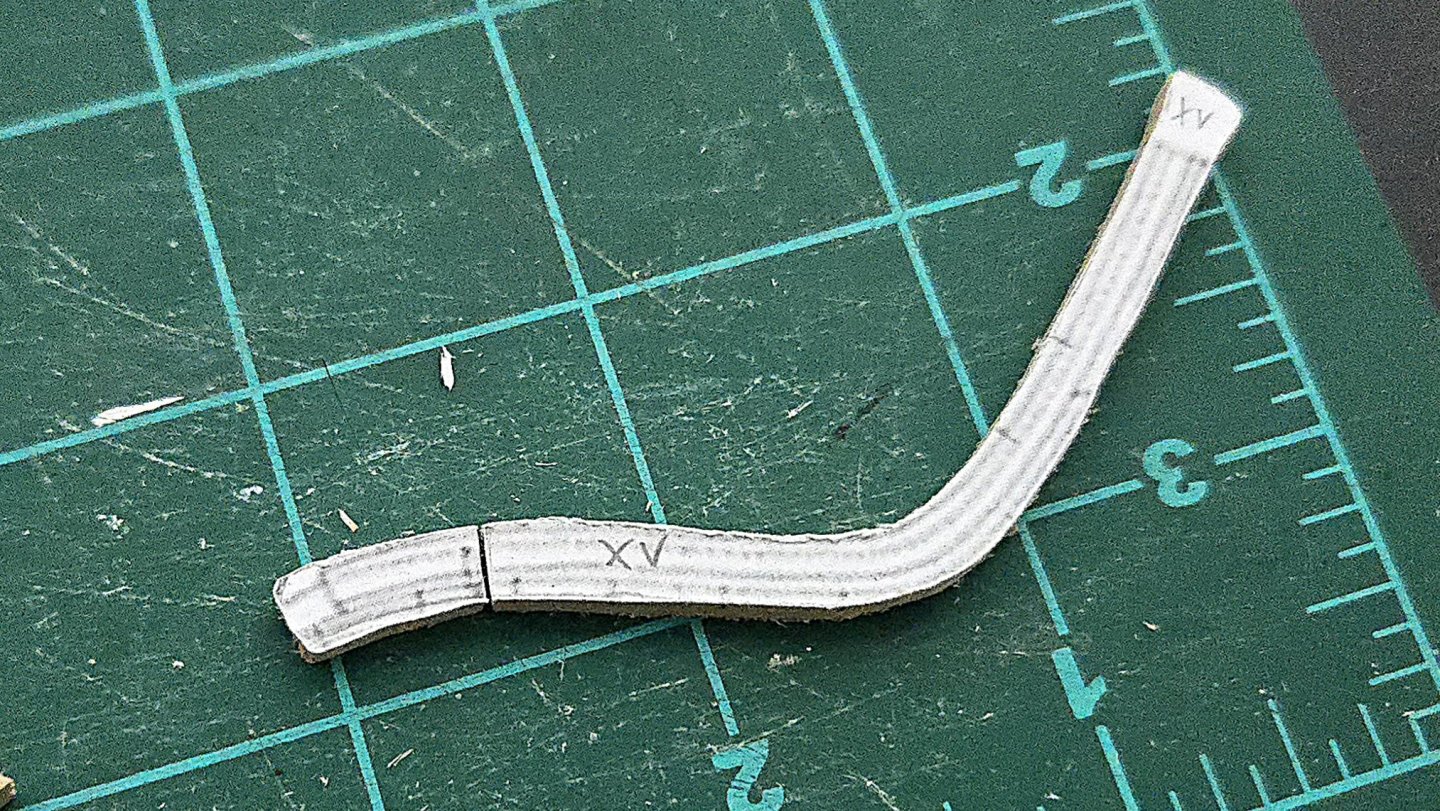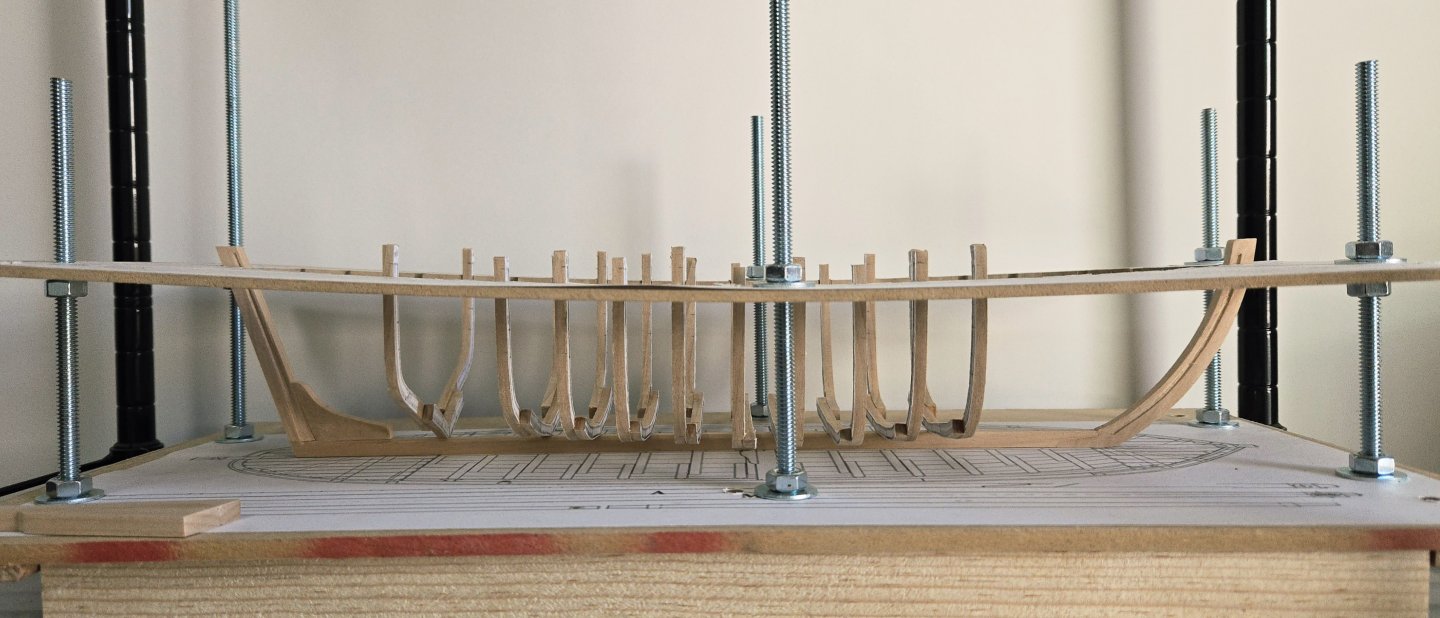-
Posts
1,308 -
Joined
-
Last visited
Content Type
Profiles
Forums
Gallery
Events
Everything posted by JacquesCousteau
-
Thanks, all, I appreciate the likes and comments! @druxey, I'll definitely give that a try to sharpen the scraper. I have a curved scraper that should be useful inside the bow and stern. I’ve also started making some curved sanding blocks from scrap pine. Still considering whether to fair the exterior or interior first, but I'll be ready either way.
- 133 replies
-
- ancre
- Bateau de Lanveoc
-
(and 2 more)
Tagged with:
-
Thanks, all, I appreciate the comments! Cant frame 1 needed some shaping at the juncture with the keel, both to get the proper angle between the two half-floors and to set up the proper shape against the keel and running up the curved stem a bit. This was tricky to get right. I didn't quite cut the right angle between the two half-floors, although that side of the joint will ve totally covered by cant frame C, the keelson, and the garboard and broad strake, so I'm ok with leaving it as is and doing better next time. I then beveled the bottom, to match the frame's rise onto the stem, in the wrong direction. Thankfully I was able to glue back on the shavings I had removed, and some extra as necessary, to build it back up to the proper size, then did it right the next time. As with the other cant frames, I found frame 1 quite challenging to properly fit. As can be seen here, with the port half left off and the starboard half dry-fit, it's an awkward fit over the juncture of the keel and stem. More challenging will be Cant Frame C, which need to butt up against the fore side of frame 1. Confusingly, while the frame drawings show these as having a flat bottom, while they actually will intersect the curved stem a distance above the line of the keel. Not to be a broken record, but it would be nice if the plan sheets properly depicted the joint between the cant frames and the keel/stem/deadwood, as a difference of a millimeter or two can really throw off the shape of the hull. At this point, I'm nearly to ready to start gluing frames to the keel. I wanted to ask if anyone has any advice about placing and fairing the frames. First, whether it's best to start with the cant frames, shaping them as you go, before adding the middle frames, or to start with the midfle frames and work out to the cant frames at the ends. Second, whether it's recommended to fair the interior first while still in the jig, then to add the interior supports and fair the exterior, or to add temporary supports across the tops of the frames, fair the exterior first, and then do the interior. I've seen all of these processes on POF builds, but I'm not sure what the pros and cons of each are. On frame order: it seems like starting with the cant frames and working inward is often recommended because it gives you more space to fair the cant frames without the middle frames in the way. But, given my difficulties with figuring out how the cant frames are supposed to be placed, I feel like it might be useful to run battens to figure out their placement, which would require that the middle frames be added first. Plus, I'd hate to start with the cant frames, fairing as I go, and later find that getting a fair hull requires removing them and adding them in a slightly different position, destroying the fairing and necessitating the redoing of the whole frame. On interior vs exterior fairing first: fairing the exterior first seems like the simplest option, and would show me pretty quickly whether the cant frames need repositioning, but adding all the necessary supports will take a good bit of scrap wood. Fairing the interior first seems more elegant--it would use less scrap wood and would make more use of the framing jig--but I don't know if there's any other reason it might be recommended. In the meantime, I've removed the paper templates from the frames, using a little rubbing alcohol to remove the glue residue. Oddly, one of my old exacto blades works really well as a scraper, while I can't for the life of me get the card scraper I bought properly sharpened (maybe I'm burnishing too hard?). I've also pre-faired the interior of the frames. Looking forward to hearing any suggestions about the frame placement order and fairing!
- 133 replies
-
- ancre
- Bateau de Lanveoc
-
(and 2 more)
Tagged with:
-
Great start, I'm looking forward to following along with your build!
- 21 replies
-
- Cala Esmeralda
- Santa Eulalia
-
(and 1 more)
Tagged with:
-
Nice job. I hadn't realized just how long the bowsprit is, once rigged this will take up quite some space!
-
I had already glued the floors to the full-length futtocks for frame 1, as given in the frame view plans and shown in the other photo-only build log I mentioned above. However, after some thought, I decided to trim back the bottom ends of the futtocks, as shown in the top-down plans. Frame 1 reaches the keel right where the keel joins the stem, meaning that there's a lot of extra shaping to fit the curved stem if you leave the futtocks full-length. This was pretty easy to do, using a razor saw to carefully cut the futtock, then applying alcohol to the part to be removed and using an xcel blade to cut it off before sanding and filing smooth. In the photo below, the bottom frame has been trimmed, while the top is next. I also decided, in the spirit of the monograph being a reconstruction and not an exact replica that must be absolutely followed, to deviate slightly from the plans regarding the aft cant frames' joints with the deadwood. The plans show this as a simple butt joint. However, as the deadwood is smooth and the cant frames have a complex curve to them, I found it extremely difficult to place them against the deadwood at the correct location. I had marked it in pencil, but it was hard to see with the jig and my fingers in the way, and the cant frames want to slide all over the surface with any pressure, especially as pressure must me exerted on the highly curved and angled exterior side. So, I decided to cut slightly into the deadwood, giving the frames just enough of a slot that they can be held in place much easier. This was done carefully with an xacto knife and a file. As can be seen, it's a very small amount that was removed, but it makes a world of difference in positioning the cant frames. I've also finished pre-fairing the exterior of the frames (except for the cant frames). With everything dry fit, the shape of the hull shines through. After six months of work, admittedly with a lot of interruptions, the model is looking more like a ship than ever. The interior of the frames still need pre-fairing before I actually glue anything. I have to say, I quite like the skeletal look, and I'm strongly considering leaving the model unplanked between the broad strake and the wales.
- 133 replies
-
- ancre
- Bateau de Lanveoc
-
(and 2 more)
Tagged with:
-
Thanks, all! Keith, I'll definitely use a batten to check fit, but I think it will have to wait until the other frames are a bit better secured. Waldemar, I greatly appreciate the reminder that the plans are merely a reconstruction, and not necessarily 100% accurate. There are many ways to skin a cat, and it's worth considering alternatives. Incidentally, this is making me realize that I was under the impression that French ships usually didn't use cant frames, although maybe that doesn't apply by 1830 or to small vessels like this one. As I've already cut the floor pieces as given in the plans, I'll try to make that work first, but may have to redo the floor and try something else. Incidentally, I realized that I was forgetting another source: the model in the Musée National de Marine, photos of which are in the monograph itself! (This is what I get for building so slowly and for doing multiple builds at once). The photos are a bit blurry. In the first, the futtocks look like they cut off just before the keel. In the second, it looks like they go nearly to the keel if not quite to it. Interestingly, cant frame C, which by the plans is supposed to butt up against frame 1, isn't visible at all, and from the angle looks like it would go to the keel further forward. Of course, on this model, the frames aren't really structural: the hull is actually a hollowed shell with planking scribed on the exterior and frames added later. The Musée National de Marine site has some nice photos of the model, although none of this detail under the foredeck. Source: https://mnm.webmuseo.com:8443/ws/musee-national-marine/app/collection/record/9718 In the meantime, the exterior of the frames have been sanded a bit. Still a long way to go, though!
- 133 replies
-
- ancre
- Bateau de Lanveoc
-
(and 2 more)
Tagged with:
-
Cant frames E, the aftermost frames, were also fairly straightforward to make. That said, I've realized that my plan to just extend them to the keel isn't going to work, as they really should end at the bearding line on the deadwood. Working out how to properly fit these is going to be very difficult, and I do wish the planset had drawn how they actually fit instead of showing them going full-length to the keel. Overall I'm finding the plan set to be very useful, but I have found a number of issues, and I'm confused by many of the choices made in drafting the cant frames especially--I haven't even gotten to cant frames A and B yet, where as I've mentioned before, the plans don't show the end of the frame pieces. Another issue is frame 1, which is slightly canted forward. Unlike the other cant frames, but like the full frames, it has a floor piece--actually, two of them, which you have to properly angle. As can be seen, the frame plans show the futtocks as nevertheless extending all the way to the keel, doubling the floors: While the side and top view show the futtocks as ending well before the keel, barely overlapping the floors, and leaving space so that cant frame C can butt up against the floors of frame 1 and the keel: Definitely a bit odd. I was curious how others have handled this. The only actual build logs I've seen are on a french modeling forum where you need an account to view images. Another site, though, shows photos (without commentary) of a build. From what I can tell, they left the frame 1 futtocks full-length and butted frame C up against them. This certainly seems like a simpler solution, requiring just one cut across the bottom of frame C instead of two. Source: https://www.alexshipmodels.com/2016/12/10/le-bateau-de-lanveoc/ At this point, I'm wondering if I should glue the full frames in place and run some battens to help determine how to place the cant frames, or if I should make another jig plate of a waterline to add below the existing one. Either option seems like it would be extremely helpful to work out the placement issues caused by the oddity of the plan set. In the meantime, while I ponder what to do, I'm pre-fairing the frames, which are currently extremely chunky compared with how they should be.
- 133 replies
-
- ancre
- Bateau de Lanveoc
-
(and 2 more)
Tagged with:
-
Next up are the cant frames. I've never made these before, so I started with frame pair D near the stern as it seemed the simplest. That said, it was still a bit tricky. As can be seen, the frame drawings show this as reaching all the way to the keel: While the side view shows it as merging into the deadwood a little higher than that. I should note that other drawings make it clear that the deadwood isn't supposed to be notched or anything. Rather than try to fit it as on the side view, I think I'm just going to make it full length to the keel and, once it's glued to the deadwood, see how it turns out with fairing. I began by trying to cut the inner angle. This took a lot of patient, minimal trimming and checking fit. Given the angle and all the jig pieces blocking the view, it's a bit tricky to hold the frame in place to check fit. You need to check alignment both in terms of landing on the deadwood correctly, not to high, low, or off fore-and-aft, and make sure the part that's hanging between the jig and the deadwood is properly lined up from the top down, as otherwise it will really throw off the hull shape. Meanwhile, without a notch or anything, the piece wants to slide all over the deadwood. All of which is to say, apologies for the poor photo quality of the test fit below! Eventually I got the inner angles about right. In contrast, beveling the bottom of the other side was much easier, I just had to pay attention to the changing grain direction around the curve.
- 133 replies
-
- ancre
- Bateau de Lanveoc
-
(and 2 more)
Tagged with:
-
Thanks, all, for the kind words and likes! Finishing up the bulkheads was straightforward. I want to note that a pair of 3-2-1 blocks can serve as an effective temporary hull clamp. These have been an incredibly useful purchase. While there have been a few tools that seemed vital that I haven't really used at all since purchasing, like my set of digital calipers, the 3-2-1 blocks have been really helpful in all sorts of ways. Definitely a worthwhile purchase. The transom was a bit tricky, as it has a curve running side to side across it and it needs to fit into a tricky angle at the stern. The kit design handles this in a really interesting way. The transom is made of two thin layers, which is easier to curve than a thick layer, and there's a small bulkhead, which gets placed in an angled slot. Ths bulkhead has the proper curve across its surface and two protrusions that fit into openings in the inner transom layer in order to properly position it. After that's attached, the outer transom layer is glued in place, lining it up with markings laser-cut into the inner layer to properly position it. It's a smart system, and attached the inner layer worked great. But, I ran into trouble attaching the outer layer. The inner layer has vertical grain, so it's easy to bend across the curve. The kit has vertical grain on the outer layer, as well. When I laser-cut the pieces, though, I set the outer layer with horizontal grain, apparently (it was a while ago and I don't quite remember) thinking that the grain on an actual transom would probably run horizontally. This meant, though, that even though it's made of thin 1/32‐inch basswood, it was practically impossible to bend the outer layer into shape. I nearly snapped the bulkhead trying to clamp it to the curve. It probably would have been possible to do it by fully soaking the piece in boiling water and letting it dry clamped to a curved form, but by the time I realized that, it was already soaked in glue on one side, and I thought that method would probably leave marks in the soft wood. Instead, I used it as a template to cut a new outer transom with vertical grain. This of course curved easily into shape. I also decided to add the centerboard control rod. From what I can tell, on an actual vessel this was most likely made of chain, but the centerboard fits very tightly in its case, and a solid rod will allow me to push it down from the top. Instead of doing a single rod, though, I'm going to try doing a 2-part rod with the joint right about at deck level when the centerboard is pulled up (which I'll arrange later, the rod is currently left overlength). This should allow the centerboard to be operated through a small hole rather than a large slot in the deck. At this point, the framework is complete.
-
Thanks! Like I mentioned, one of the changes I was considering was to deepen the cockpit a bit. The more research I did, though, I found contradictory information. Chapelle describes these vessels as having "deep" cockpits, although without giving any measurements or including the cockpit floor in his plan. He does, however, describe there as being at most five floors laid directly over the frames, which would seem to suggest a pretty low cockpit. The kit design, in contrast, is for a cockpit about 18 inches deep (not counting the coaming), with a very short bench about 9 inches off the cockpit floor. Dee Dee's build (which I should note is based on Midwest's kit) includes what I think is a convincing reconstruction of Chapelle's written description. Below, a figure in the cockpit showing the unaltered depth. I should note the figure was drawn for my Canoa de Rancho build and is likely an inch or two on the short side for Maine c.1880. The small size of this vessel is clear. Looking beyond Chapelle, other sources show or suggest something different. Looking at the construction drawing of the Ranger (in my previous post, and I should note that at 21 feet 10 inches long it's less than a foot shorter than my model), the floor is shown to be about 1.75 feet below the deck. This is pretty similar to the kit design, although the Ranger has a taller bench, about 1.25 feet high, which seems much more comfortable than the 9-inch-tall bench given by the kit. According to Ansel, who physically visited the vessel, "Standing in the cockpit, you notice that it is a good working height if you are handling lobster traps" (24). Less than 2 feet high sounds a little short for comfort to me, but I've never handled a lobster trap, so I'll take his word for it. Some photos, like the one in my last post of the Lucille, also seem to show a similar cockpit. While the Lucille's helmsman is seated, I think his foot is on the floor rather than up on the seat, and it looks like the cockpit is about knee-high. So, how to square Chapelle's description of a deep cockpit with the other evidence of shallower ones? Well, when I was starting this build, I hoped to build the most accurate model I could of a Muscongus Bay Lobster Smack, but I increasingly don't think there's a single "type." Rather, there were a wide assortment of vessels that can be clustered together by some definitive features--sloop rig, centerboard, cockpit, and overhanging stern to allow for handling fishing gear without snaring the rudder--but which didn't necessarily coincide in secondary characteristics, such as the depth of the cockpit (or the presence of a beakhead/clipper bow, for that matter). And that's not to mention change over time, of which I think we can trace the general outline of but can't speak to every detail (or, given limited evidence, to necessarily distinguish which differences between vessels come down to historical development and which are explained by differing local design traditions, owner preference, etc). So, for the cockpit depth, I don't think there's one accurate way, but a few different ways, any of which will provide a reasonably accurate model as long as care is taken to find evidence for them. So, all that said, I decided to only slightly deepen the cockpit to a little under 2 feet deep (at scale), but, following the example of the Ranger, to raise the bench to a more useful height. I shaved and sanded a bit over 1/16‐inch off the support for the cockpit floor on the backbone. I'll also be planking the deck and using the kit design as a false deck, which will add an extra inch (full scale) to the depth. I trimmed a corresponding amount off the bulkhead that runs across the bottom of the cockpit. This is another area I'll be modifying. As seen in the photo below from the kit instructions, the kit leaves the sides of the bulkheads whole. It doesn't look bad at all, but isn't quite accurate. Photos and the diagram of the Ranger show that the actual frames would have been much thinner, and possibly covered by ceiling planks. I have yet to decide exactly how I'll handle this, but either way, I'll need to remove the sides of the bulkheads at some point. My plan is to leave them in place for planking, but not to glue the planks to them, and to remove the bulkhead sides after planking, leaving the bottom to seat the floors. With that in mind, I drew some lines to indicate where to cut later across the bulkheads, and slightly scored them so it will be easier to remove the unnecessary material later. These tasks completed, I began gluing the bulkheads in place along the backbone. I used my 3-2-1 blocks, as seen, to hold them perpendicular. However, I soon realized that, as I was focused on getting everything perpendicular to the backbone, I wasn't paying enough attention to the alignment, and there was a bit of a twist to bulkheads 4 and 5. Using rubbing alcohol, I removed them and reattached them, keeping a closer eye on alignment from every direction. By now, I'm nearly done with gluing the bulkheads in place.
-
(Post broken into two due to length.) History and Design Maine’s coast is famously rugged, and Muscongus Bay is, according to the Maine Coast Heritage Trust, “especially mercurial,” regularly swept by southwest winds. The bay is dotted with islands and, by the nineteenth century, had several small towns along its shores, including the town of Friendship on the east side of the bay, and Bremen to the northwest. The bay is apparently still known today for its fisheries. The Muscongus Bay Sloop, and from it, the similar but larger Friendship Sloop, developed on the bay in the years after the American Civil War. Maine had long been the center of a large fishing industry, including both inshore and offshore fishing, with influence between the two. Centerboards came into use around the middle of the nineteenth century, and in the 1860s and 1870s, boatbuilders in Bremen, Bristol, and Friendship began adding centerboards, sloop rigs, and partial decks and cuddies to open rowboats, in order to create a vessel suited for inshore fishing. According to Chapelle’s American Small Sailing Craft and Duncan’s Coastal Maine, these were usually lapstrake-planked vessels, usually 16 to 26 feet long, with minimal drag, a coaming to help keep the cockpit dry. They were often relatively lightly built and intended for work during the warmer months of the year, and their masts were generally unstayed. Duncan, especially, suggests that they shared some design elements (but in miniature) with the Gloucester clipper schooners then in use for fishing the banks offshore (Duncan, 426). Caravel planking seems to have come into use in the 1880s. Goode’s The Fisheries and Fishing Industries of the United States (1884-1887) describes the Muscongus Bay lobster fishery as using “small square-sterned sloops, open in the after part, but with a cuddy forward. They are all built with center boards, and some are lapstrake” (Vol. III, 670). From the 1880s onward, the type underwent substantial changes. As Duncan notes, the expansion of rail and steamship lines into Maine’s middle coast in the 1880s made Boston’s fresh fish market available to Maine’s fishermen, who now could have their catch available to consumers there within a day. The expansion in the market created a need for a larger, more seaworthy fishing vessels capable of meeting year-round demand (Duncan, 427-428). At the same time, as Duncan and Chapelle discuss, the clipper schooner design used for offshore fishing was increasingly criticized as unsafe, leading to a shift toward proportionally deeper and wider schooners. These changes appear to have shaped the design of Muscongus Bay’s inshore workboats, which became increasingly larger and deeper, leading to the development of the Friendship Sloop (named after the town that became known as the center of their construction, although they were built elsewhere). The Friendship Sloop was substantially larger, often 30-40 feet long, usually had two headsails and stays, and had a deeper hull and keel instead of a centerboard. The type, which increasingly supplanted the earlier centerboard sloops, became quite popular as a fishing vessel and, eventually, as a yacht, leading to a great deal being written about it. Bringing together different sources, then, it’s clear that the Muscongus Bay Sloop is something of a moving target—far more so than the Friendship Sloop, at least. Its cabin and deck arrangement could vary, it could be lapstrake or caravel-planked, and might or might not have a clipper bow. Chapelle’s plans in American Small Sailing Craft show essentially a shallower, smaller variant of the Friendship Sloop with a centerboard, featuring a a prominent cabin. Notably, these plans seem to have been used as the basis for the Model Shipways kit, as well as the kits by Midwest and Bluejacket (at least, I think so based on photos). Source: Chapelle, American Small Sailing Craft, 267. Chapelle based his plans in part on builder’s half-hull models, a hulk in Kennebunk, and a model in the National Watercraft Collection. Notably, he says that the hulk was caravel planked, and that the National Watercraft Collection model, “though finished caravel, was evidently intended to represent a lapstrake boat, judging by the model builder’s use of a lower moulding on the sheer strake” (Chapelle, The National Watercraft Collection, 253). Although his plans say that the vessel was lapstrake planked, the 3-D view doesn’t show this, and as far as I’m aware, none of the model kits of Muscongus Bay Lobster Smacks show lapstrake planking. But other sources show quite a different-looking vessel. This photo in Duncan’s Coastal Maine shows a Friendship Sloop in the center and what he identifies as a Muscongus Bay Sloop in the foreground. The latter is not only distinctly smaller than the former, but has a much smaller cabin, an unstayed mast, and lacks the clipper-style bow with the prominent beakhead of the larger vessel, instead having more of an upright stem. Source: Duncan, Coastal Maine, 430. Photos show similar-looking vessels in a range of sizes, such as the small Secret, shown below (which, in other photos, has a small bowsprit and jig). Described in the caption as a small Friendship Sloop, it looks more like the vessel Duncan identified as a Muscongus Bay Sloop but lacks even the cabin forward. Source: https://penobscotmarinemuseum.historyit.com/items/view/digital-collection/190393/search?resultsMode=search&searchInterfaceId=1&search=eyJycSI6WyI4NjM5Il0sImlwIjoxLCJvYiI6InNjb3JlIiwibyI6ImRlc2MiLCJwcyI6MjQsInYiOiJncmlkIiwicmNpIjoxLCJzc2YiOjEsInByZSI6MSwicmEiOltdLCJ2aWV3TW9kZSI6ImdyaWQiLCJwZyI6MH0= There’s also this rather larger vessel, identified in the caption as the Muscongus Bay Sloop Lucille, built in 1900. Notably, it also lacks the beakhead, again having a rather vertical stem, and despite its size, seems to have an unstayed mast. Based on the visible strake lines near the bow, it may be lapstrake planked, although it’s hard to tell. Source: https://penobscotmarinemuseum.historyit.com/items/view/digital-collection/198660/search?resultsMode=search&searchInterfaceId=1&search=eyJxIjp7InNmMTI3IjoibXVzY29uZ3VzIn0sIm9iIjoic2NvcmUiLCJvIjoiZGVzYyIsInBzIjoyNCwidiI6ImdyaWQiLCJyY2kiOjAsInNzZiI6MCwicHJlIjoxLCJpcCI6MSwicmEiOltdLCJ2aWV3TW9kZSI6ImdyaWQiLCJwZyI6MX0= Similarly, the reconstructed plan of the Ranger included in Willits D. Ansel’s “The Boat as Record” shows a vessel similar in many respects to that shown in Chapelle’s plan, but a little deeper, with more pronounced drag, and lacking the beakhead. Interestingly, it also apparently had a pair of stays in its original configuration, before being given more extensive shrouds after conversion to a yacht. Source: Ansel, “The Boat as Record,” 26. All of which is to say, there’s a lot of variety among Muscongus Bay Sloops. I think this points to some of the problems with assuming a “canonical” design will hold true for a vessel type. While Chapelle’s plans have clearly been influential, various aspects of the design he gave weren’t necessarily typical. As a workboat, every Muscongus Bay Sloop was different, based on the needs of the job, resource availability, owner preference, and the boatbuilders’ own styles and traditions. Based on sources like these, I’m considering a few modifications to the kit design. The biggest change would be to switch from caravel planking to lapstrake planking. This would be a challenge, but I think a fun one. I’m also planning on not adding stays to the mast—while the Model Shipways kit includes them, possibly because it’s intended as a learning experience, the Midwest kit doesn’t, and sources seem pretty clear that stays were rare (though not unheard of) on these vessels. I’m also considering reshaping the stem to do away with the beakhead, and possibly to get a slightly more upright/curved stem instead of the current stem that juts forward (which would, in turn, require slightly reshaping the foremost bulkheads as well). Finally, I’m thinking of slightly deepening the cockpit, as I’ll discuss in the next post.
-
I’m starting to reach the point in this build where I’ll be making some modifications (besides the rescaling), so I think time to talk a little bit about the sources I’m using and the history of the vessel type. Like I’ve mentioned earlier, the Muscongus Bay Lobster Smack (also often just called the Muscongus Bay Sloop) is a very popular model and quite a bit has been written about it. I’m certainly not breaking any new ground here. Sources There are many useful sources on this vessel. Howard I. Chapelle wrote at some length about the Muscongus Bay Lobster Smack and its successor design, the Friendship Sloop, in several books. His early work American Sailing Craft (New York: Kennedy Brothers, Inc., 1936) briefly touches on the Muscongus Bay type on page 34, but is mostly focused on the Friendship Sloop. More useful is his The National Watercraft Collection (Washington, D.C.: Smithsonian Institution, 1960), which includes a photo and a description of a model in the eponymous collection (pp. 253-254), and especially American Small Sailing Craft: Their Design, Development, and Construction (New York: W.W. Norton & Co., 1951). This last book includes a set of plans and a 3-D view of the hull, which Chapelle reconstructed from several sources (more about which later) as well as a fairly detailed description (pp. 266-269). Chapelle’s plan seems to be the basis of this kit. Besides Chapelle’s work, I’ve also found it very helpful to consult Willits D. Ansel’s “The Boat as Record,” pp. 19-26 in Lipke, Spectre, and Fuller, Eds., Boats: A Manual for their Documentation (American Association for State and Local History; Museum Small Craft Association, 1993). Ansel’s brief chapter about how to read a vessel’s history through the physical traces left on its hull takes as its example the Muscongus Bay Sloop Ranger, held in the collections of the Maine Maritime Museum (a vessel which I haven’t been very successful in finding many photos of). While Ansel shows how the Ranger changed over time as it became a yacht, the article also includes a construction drawing, including scantlings, for a reconstruction of how the sloop likely looked when it was built as a fishing boat. I’ve also consulted Roger F. Duncan’s Coastal Maine: A Maritime History (New York: W.W. Norton and Co., 1992), and Lincoln Paine’s Down East: An Illustrated History of Maritime Maine (Second Edition; Lanham: Down East Books, 2018; Originally Published 2000), for context on Maine’s maritime history and its lobster fishing industry. As for primary sources—that is, sources created at the time of the vessel’s use—Volume 5 of Souvenirs de Marine by François Edmond Pâris includes a sail plan (Plate 244), and there’s a very brief description in G. Brown Goode, The Fisheries and Fishery Industries of the United States (Washington: Govt. Print Off., 1884-1887), specifically in Vol. III, p. 670. More useful, though, have been a number of photos available online through the Penobscot Marine Museum (https://penobscotmarinemuseum.historyit.com/public-sites/home/digital-collection). The search function is a little wonky, and I’ve found many more photos of Friendship Sloops than of the earlier Lobster Smack type, but these images are extremely useful, especially for working out details that aren’t shown in plans. They’re also interesting as a window into fishermen’s lives and livelihoods in the era. The undated photo below, for instance, shows the old hull of a sloop hauled up on shore with paint worn or stripped off, in front of a huge pile of lobster traps: Source: https://penobscotmarinemuseum.historyit.com/items/view/digital-collection/261929/search?resultsMode=search&searchInterfaceId=1&search=eyJxIjp7InNmMTI3Ijoic2xvb3AiLCJjdXN0b21fZmllbGRfOTgwIjoibmF0aW9uYWwgZmlzaGVybWFuIGNvbGxlY3Rpb24ifSwicGciOjEsIm9iIjoic2NvcmUiLCJvIjoiZGVzYyIsInBzIjoyNCwidiI6ImdyaWQiLCJyY2kiOjAsInNzZiI6MCwicHJlIjoxLCJpcCI6MSwicmEiOltdLCJleCI6eyJjdXN0b21fZmllbGRfOTgwIjoxfSwidmlld01vZGUiOiJncmlkIn0= While the photo below, also undated, shows Edward F. Woods and his daughter Mary Benton in front of several workboats, including a Friendship Sloop, on the waterfront of Eastport, Maine. Woods was apparently the oldest sailor in Eastport at the time. Source: https://penobscotmarinemuseum.historyit.com/items/view/digital-collection/259752/search?resultsMode=search&searchInterfaceId=1&search=eyJxIjp7InNmMTI3Ijoic2xvb3AiLCJkYXRlIjp7InN0YXJ0IjoiMTkwNS0wMS0wMVQwMDowMDowMFoiLCJlbmQiOiIxOTA1LTEyLTMxVDExOjU5OjU5WiIsIm9wZXJhdG9yIjoiaW50ZXJzZWN0aW5nIn19LCJwZyI6MCwib2IiOiJzY29yZSIsIm8iOiJkZXNjIiwicHMiOjI0LCJ2IjoiZ3JpZCIsInJjaSI6MCwic3NmIjowLCJwcmUiOjEsImlwIjoxLCJyYSI6W10sImV4Ijp7ImRhdGUiOjF9LCJ2aWV3TW9kZSI6ImdyaWQifQ== Finally, there are a lot of great build logs on ModelShipWorld of this vessel type. Among them, Dee Dee’s build is particularly interesting, not just because he made an excellent model, but because he includes a lot of interesting discussions about the type’s history and design. In particular, he talks about the replica Muscongus Bay Sloops built in the 1970s, and how their addition of stays on the mast seems to have been behind a number of accidents (basically, the unstayed mast was flexible enough to spill air when hit by an overpowering gust, which the stayed mast could not do). Unfortunately, many of the photos in the log don’t load for me, but it’s an excellent source. These sources have given me a few ideas about how to modify the kit design into something a little different.
-
As someone who got started in this hobby after visiting the Santa Eulalia (below, a photo of the half-hull model that's hanging on the cabin wall in the actual ship), I know which one I would choose. But it really depends on what you're interested in. Which ship catches your attention more? I'd say that, if you want to try kitbashing, the Santa Eulalia would be a very good option. The Barcelona Maritime Museum has a plan set available, and there are lots of photos.
-
Very interesting project, I'm looking forward to following along! I came across Piedrabuena's fascinating story while I was working on my lancha chilota model, which as you note is a similar type of vessel. I have to wonder how common these small sloops were on the Argentine side of the Straits of Magellan, I haven't found all that much yet about Argentine workboats from the period. I'd be curious to know how the plans were made, as I'd guess they're a reconstruction. Very nice start!
-
Congratulations, it looks great! Very nice work for a first or a seventh model, you clearly built a lot of skills over the course of the build.
- 177 replies
-
- Sherbourne
- vanguard models
-
(and 3 more)
Tagged with:
-
Two more frames--II and III--glued up and dry-fit. At this point, only the cant frames are left. The shape of the hull is really starting to come together by now. But, an issue. Looking at the side view in the plans, you can see that several frames are supposed to extend beyond the sheer. But of the frames I've made so far (II-XV), only II extends beyond the sheer. XII, XIV, and XV all end at the sheer, following the frame sheet of the plans, when the side plans show them as extended. It's a little hard to tell because I've left all frames a little long, which I suppose means I can try to extend them a bit, but maybe not quite as much as given in the plans. I have to admit that this is very frustrating--part of the point of buying a plan set like this, instead of developing this all from scratch, is that you assume the plans will be consistent between sheets. Ah well, I guess that the extensions will just be a little stumpy compared with the plan sheet.
- 133 replies
-
- ancre
- Bateau de Lanveoc
-
(and 2 more)
Tagged with:
-

Model shipways HMS Vanguard
JacquesCousteau replied to jefferyconley038's topic in Wood ship model kits
I wasn't aware that Model Shipways had ever offered that model, but it looks like they did for a short time. You might want to check out this build log for the kit: -
- 133 replies
-
- ancre
- Bateau de Lanveoc
-
(and 2 more)
Tagged with:
-
Well, once again I said I was looking forward to getting back to work on this build, and then made very little progress. I made a few more frames, and, while working on autopilot, accidentally trimmed one futtock at the wrong point, as seen below, and had to remake the piece. Despite that, yesterday I reached an important milestone: upon cutting out the frame pieces below, I have now finally finished sawing out all the frame parts! (Unless I have to remake more...) It certainly took a while to reach this point, and indeed, pretty much every aspect of this build is going slowly. There are a few reasons for this. I can only access the fretsaw in the carpentry workshop. I've only been able to attend a few times over the past month, and have been focused there on making a tea box, so I haven't had much time for sawing. The plan sheet takes up pretty much all my workspace at home, making it a bit of a hassle to glue up the frames, and the sanding generates a ton of dust--even with a mask on, I prefer to do it on out balcony, but that means I can only sand during the day when it's not raining (and when we haven't hung laundry there to dry). Not to mention that slowly sanding the frames is pretty tedious work. But this build is more of a marathon than a sprint. Two more frames were glued up last night: At the moment, I have ten frames glued up and dry-fit, although they'll need a lot more shaping before they can be glued. I'll also need to figure out the cant frames soon.
- 133 replies
-
- ancre
- Bateau de Lanveoc
-
(and 2 more)
Tagged with:
-
Congratulations, very nice job! I love the look of lateen-rigged vessels, and it's been interesting to follow your build log. The model fits well alongside the rest of the fleet. Looks like you may need another shelf soon!
- 65 replies
-
- sultan
- Artesania Latina
-
(and 2 more)
Tagged with:
-
Thanks! There will be some much more substantial modifications to come, but I'm still figuring them out. For example, Chapelle's plans don't specify how far below deck the floors or seats should be, to my eyes the kit design looks a little short so I'm considering deepening the cockpit a bit (which Dee Dee, in his build log, seems to have done, but most of the photos don't load for me). So I'll need to work that out before I glue anything into place.
About us
Modelshipworld - Advancing Ship Modeling through Research
SSL Secured
Your security is important for us so this Website is SSL-Secured
NRG Mailing Address
Nautical Research Guild
237 South Lincoln Street
Westmont IL, 60559-1917
Model Ship World ® and the MSW logo are Registered Trademarks, and belong to the Nautical Research Guild (United States Patent and Trademark Office: No. 6,929,264 & No. 6,929,274, registered Dec. 20, 2022)
Helpful Links
About the NRG
If you enjoy building ship models that are historically accurate as well as beautiful, then The Nautical Research Guild (NRG) is just right for you.
The Guild is a non-profit educational organization whose mission is to “Advance Ship Modeling Through Research”. We provide support to our members in their efforts to raise the quality of their model ships.
The Nautical Research Guild has published our world-renowned quarterly magazine, The Nautical Research Journal, since 1955. The pages of the Journal are full of articles by accomplished ship modelers who show you how they create those exquisite details on their models, and by maritime historians who show you the correct details to build. The Journal is available in both print and digital editions. Go to the NRG web site (www.thenrg.org) to download a complimentary digital copy of the Journal. The NRG also publishes plan sets, books and compilations of back issues of the Journal and the former Ships in Scale and Model Ship Builder magazines.


